This is a list of 10 digital marketing channels. And a step-by-step guide on how you can use them to drive more business.
We’ve used the channels and tactics in this guide to bring more than 35M visitors per month to our site (data from Traffic Analytics).
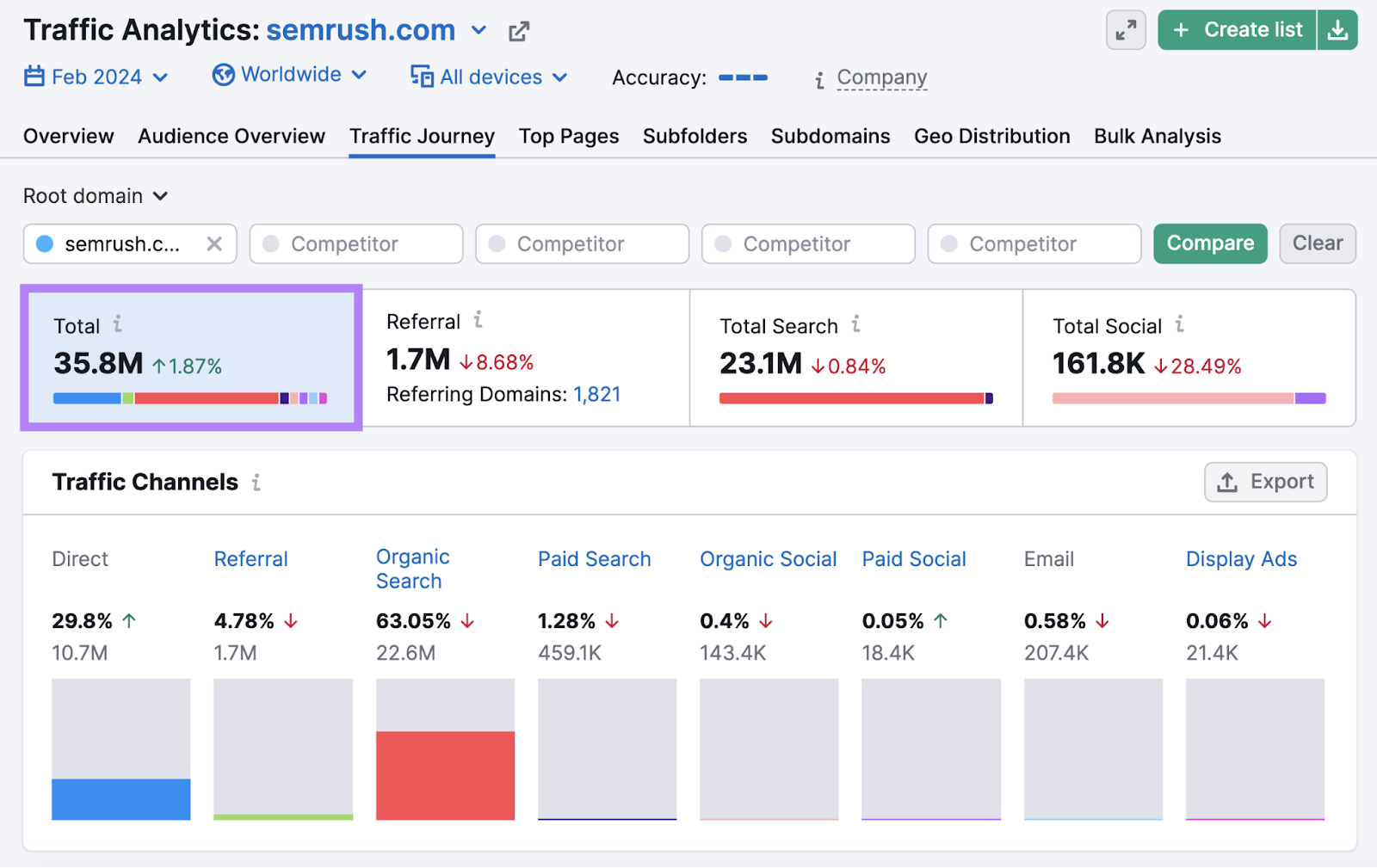
But before we get into the specifics, let’s get the basics down first.
What Are Digital Marketing Channels?
Digital marketing channels, also known as digital advertising channels, are various online platforms and methods businesses use to promote products, services, or brands to consumers.
Digital marketing channel examples include websites, social media, email, SEO, PPC, and content marketing.
All of which allow businesses to reach and engage with their audience in the digital space.
Let’s take a look at the most important digital marketing channels.
10 Effective Digital Marketing Channels for 2024
1. Website
A website is the online representation of your business or brand.
It’s where you showcase your products, services, values, and personality to potential customers. To attract, engage, and convert your audience.
For example, here is Semrush’s website homepage:
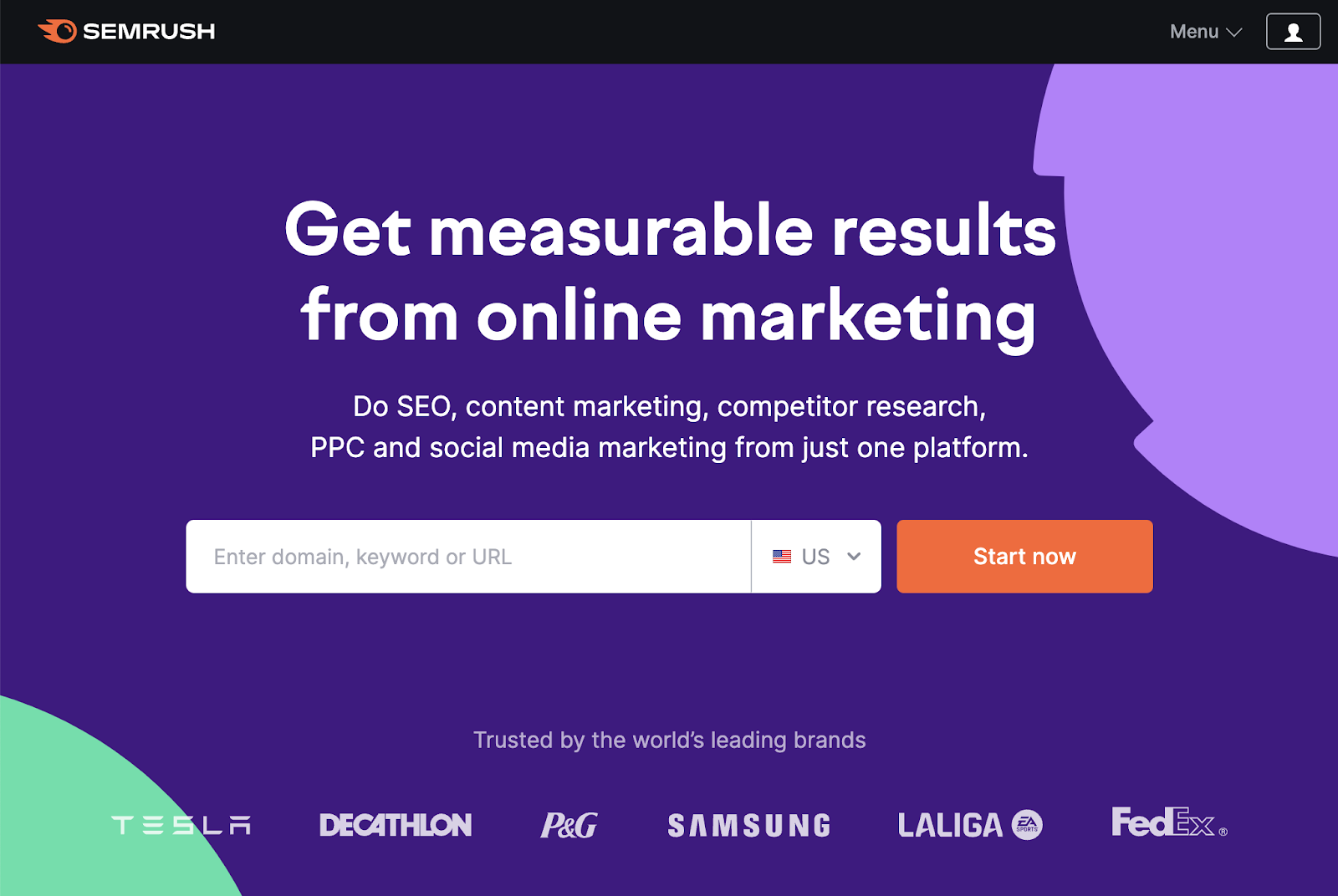
It represents the Semrush brand. And tells visitors exactly what they can do with a subscription.
Websites are also great digital marketing channels because they can:
- Build credibility and authority in your niche
- Increase the visibility and reach of your content
- Provide a platform to communicate and interact with your audience
- Collect data and feedback from visitors
- Allow for more versatile marketing campaigns
How to Get Started with Your Website
Before you design your website, you need to understand who your audience is and what they want.
You need to know about their demographics, preferences, pain points, and goals.
A great way to start gathering this information with One2Target. Just enter your domain and you’ll get tons of data about your visitors.
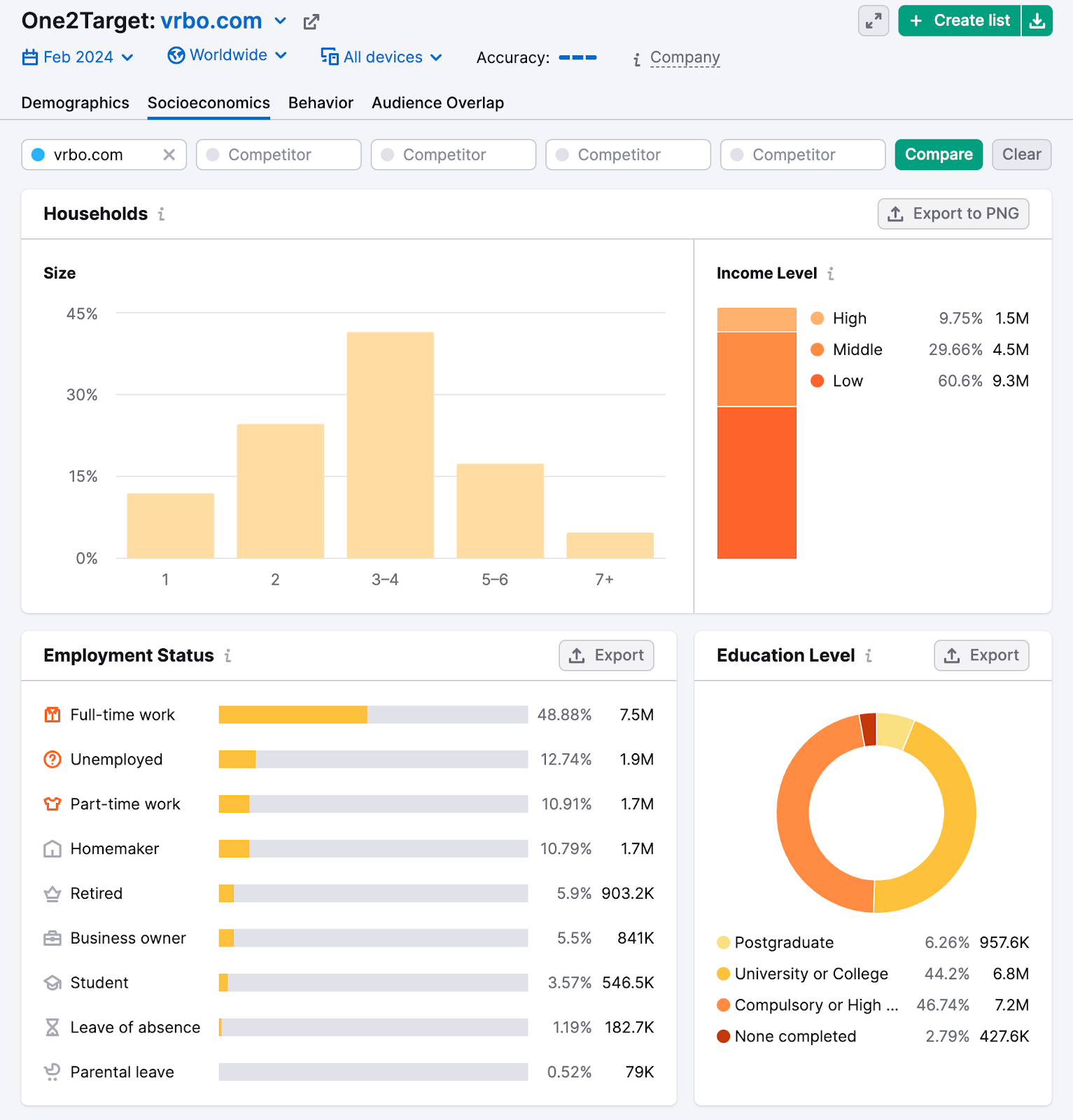
The second step is to design your website with your audience in mind.
Luckily, hosting and website-building sites like Wix and WordPress have ready-made templates you can adjust to suit your audience.
Meaning you can have a user-friendly website within seconds. And just optimize it for your unique style.
When doing so, pay close attention to the following website elements:
- Structure: How your website is organized and laid out. You want to make it easy for your visitors to navigate pages and find what they’re looking for.
- Content: What your website says and shows. You want to provide valuable and engaging information that answers your visitors’ questions and solves their problems.
- Style: How your website looks and feels. You want to create a consistent and appealing visual identity for your website that reflects your brand personality and values.
And the third step is to test and optimize your site for your target audience.
Measure how your site performs and how your visitors interact with your site with tools like Google Search Console or Site Audit. And then use the data collected to make small changes that speak to your audience even better.
Further reading:
- Target Audience: What It Is & How to Find Yours [+ Examples]
- How to Build Your Website Architecture for SEO
2. Search Engine Optimization (SEO)
SEO is the process of improving your site’s visibility in search engines. It can help you drive more organic (unpaid) traffic, leads, and sales.
SEO is one of the most effective digital channels because it helps you reach your target audience when they’re looking for the products or services you offer.
For example, investment firm Charles Schwab created a landing page targeting the keyword “Roth IRA.”
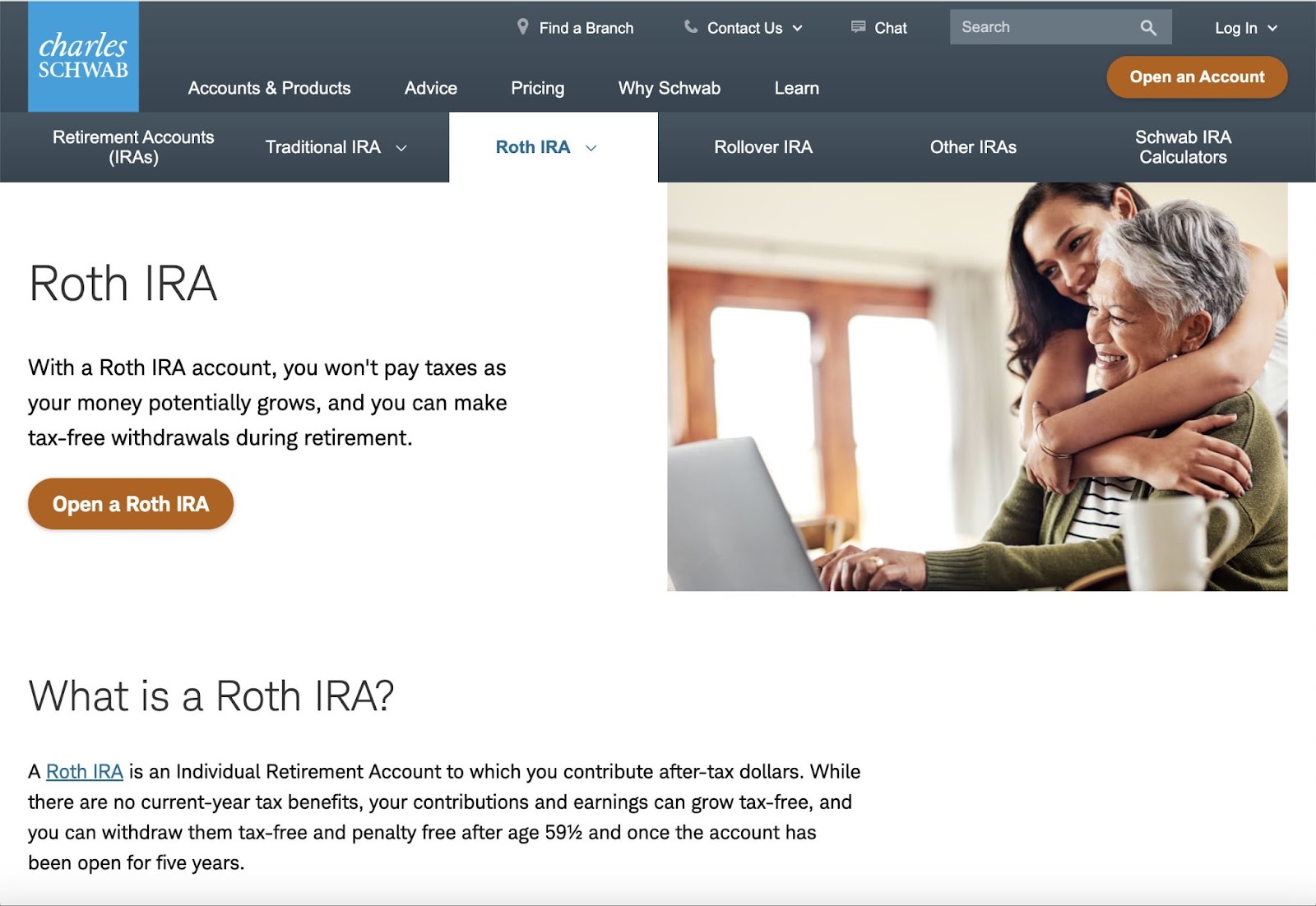
The landing page is optimized using secondary keywords like “what is a Roth IRA” and “why consider a Roth IRA,” among other things.
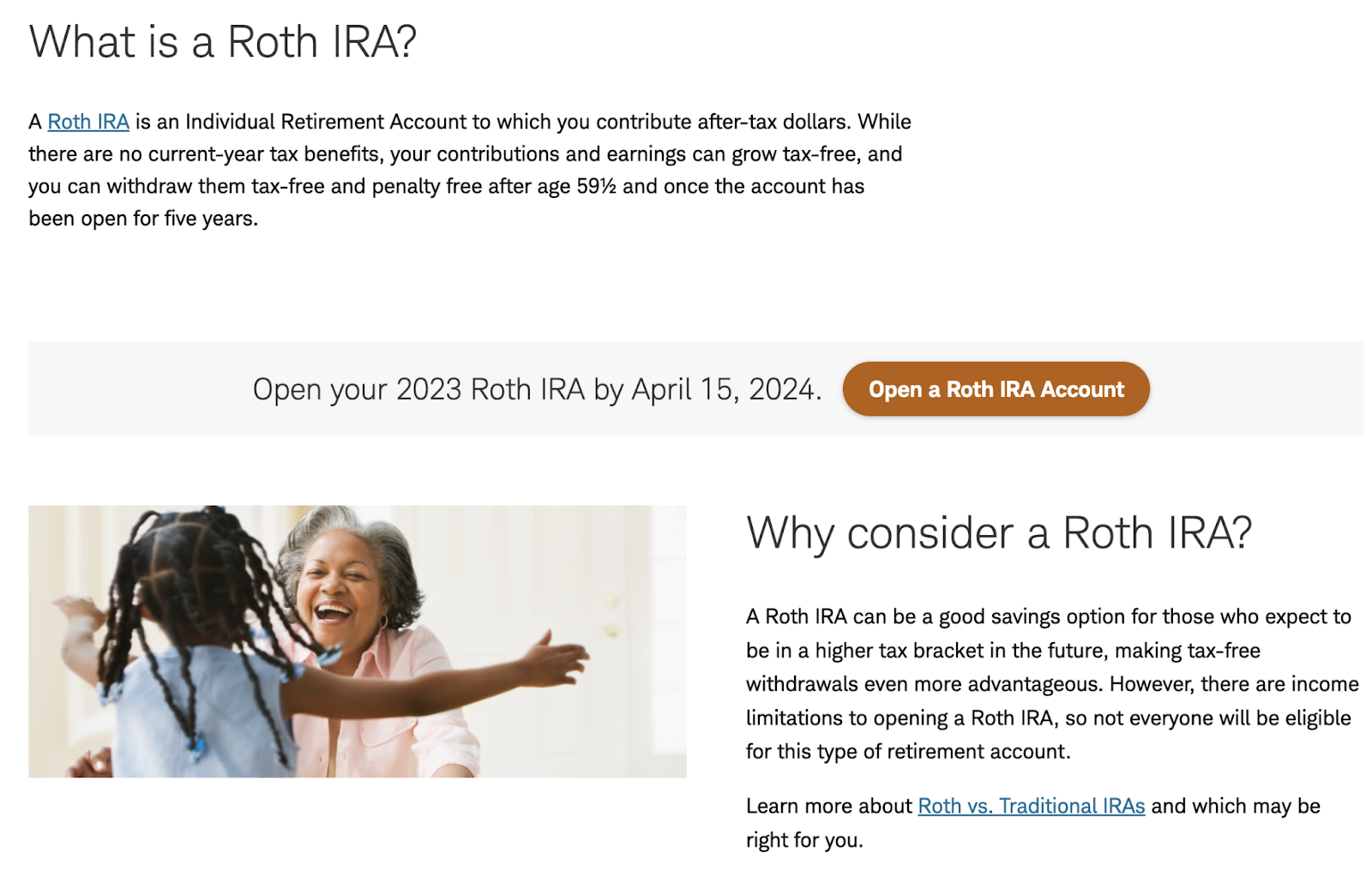
And that page ranks number one on Google. With a featured snippet, at that.
So anyone looking up Roth IRAs will probably see and click on the link to Charles Schwab’s landing page.

Which is probably why the page gets around 327K organic visitors per month, according to the Organic Research tool.

How to Get Started with SEO
Here are three steps to get started with SEO:
Do Keyword Research
Keywords are the words and phrases users type into search engines.
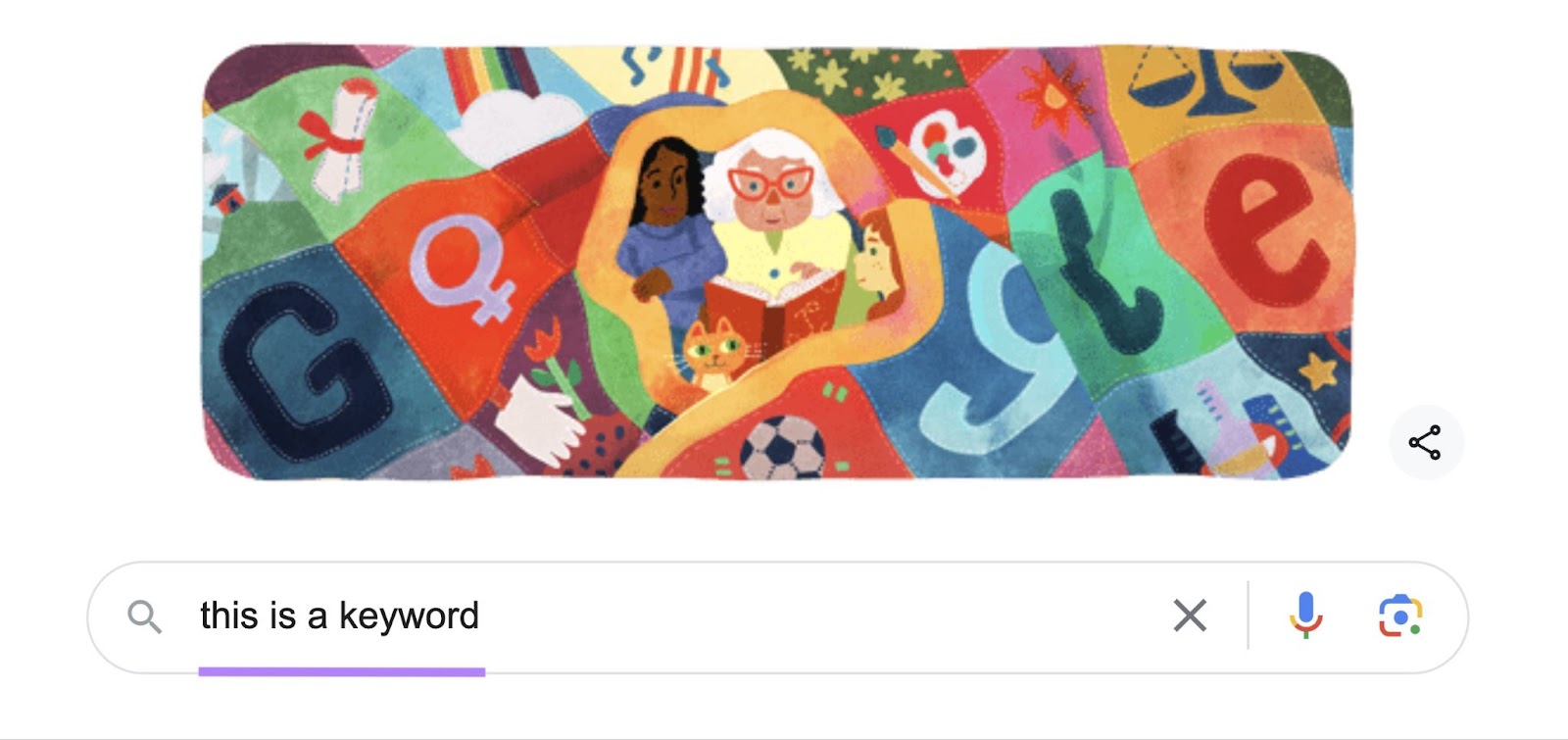
Your first step to effective SEO is to find which keywords your target audience is using to search for products or services like yours.
You can use keyword research tools like the Keyword Magic Tool to discover and analyze keywords.

Start by choosing keywords with high search volume, low competition, and high relevance for your website.
Further reading: How to Do Keyword Research for SEO (A Detailed 3-Step Guide)
Optimize for On-Page SEO
The second step is to optimize your pages for your target keywords.
On-page SEO is the practice of crafting your content to match searcher intent. I.e., turning your content into what searchers want to see when they search for a specific keyword.
And optimizing some technical aspects of your pages to make them more user-friendly for visitors.
You can use a tool like On-Page SEO Checker to crawl your site and get optimization ideas.
Like this:
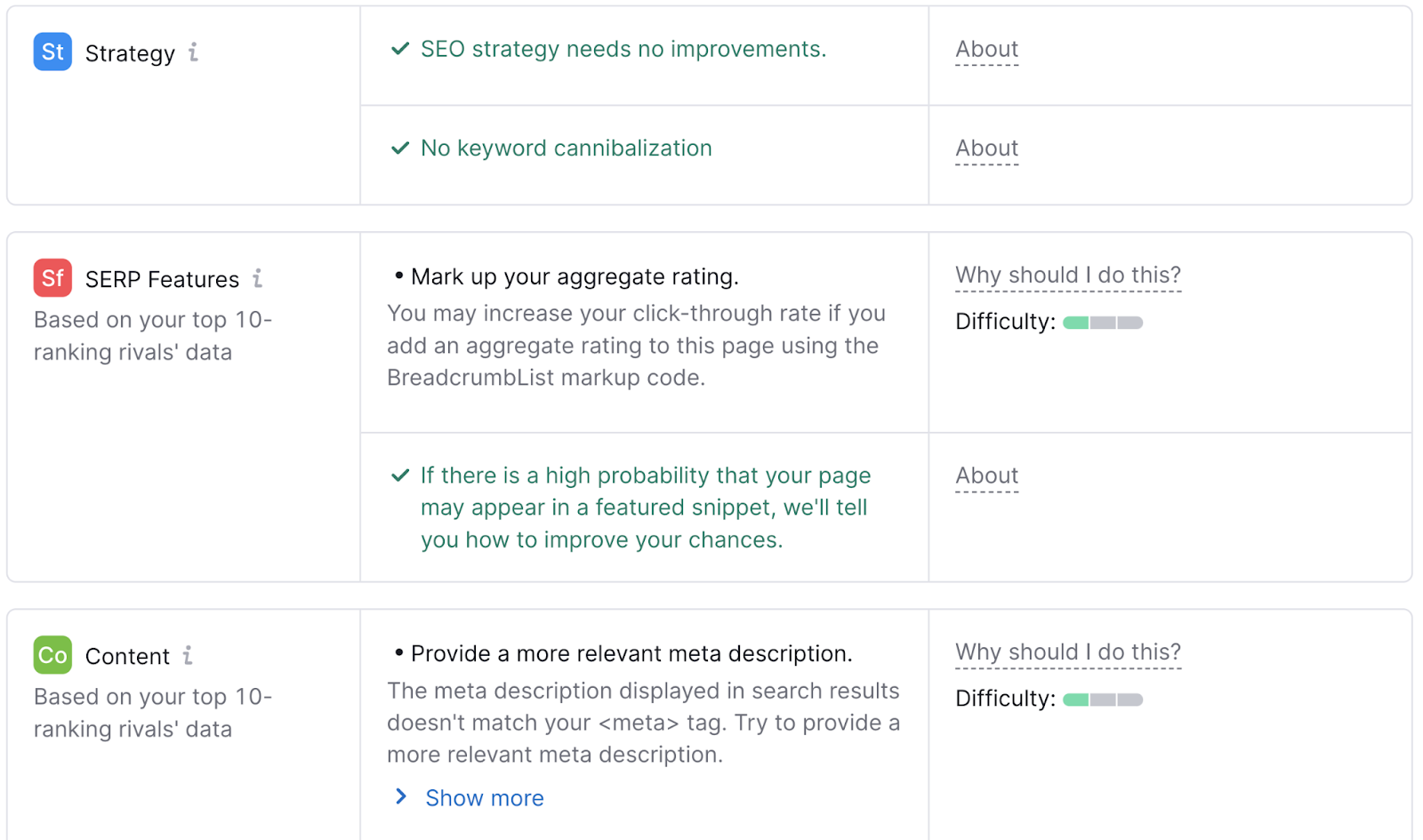
Common tasks associated with on-page SEO involve optimizing aspects of your content such as:
- Title tags: Title tags are the clickable headlines that can appear on the search engine results pages (SERPs). Include your target keyword and a compelling value proposition in title tags.
- Meta descriptions: Meta descriptions are snippets of text that can appear below the title tags on the SERPs. Include your target keyword and a clear call to action in meta descriptions.
- Headings: Headings are words or phrases that structure your pages. Use headings to organize content and include your target keyword and related keywords in your headings.
- Content: Content is the main text and images that convey your message and offer on your pages. Create content that is valuable, engaging, and relevant for your target keyword and audience.
- URLs: URLs are the web addresses that identify your pages. Create URLs that are short and descriptive. And include your target keyword.
Further reading: On-Page SEO: What It Is and How to Do It
Optimize for Off-Page SEO
Off-page SEO is the practice of increasing a website’s popularity and reputation through external factors, such as links, local SEO, and reviews.
Which means that the third step is to build your website’s authority and trustworthiness.
You’ll want to focus on aspects such as:
- Backlinks: Backlinks are links from other websites that point to yours. They’re like votes of confidence for your website. Which is why pages with lots of high quality backlinks often rank higher on Google. Try to get backlinks from high-quality and relevant websites that have authority and trust in your niche.
- Local SEO: Local SEO blends both on-page and off-page optimization. It involves using the Google Business Profile, reviews, local citations, and other key features to rank in Google’s map results. Which makes local SEO a key part of your off-page SEO strategy.
Further reading: SEO Basics: The Ultimate Guide to SEO for Beginners
3. Content Marketing
Content marketing is a strategy that involves creating and sharing valuable, relevant, and engaging content to attract and retain a specific audience.
It can include different formats, such as blog posts, ebooks, infographics, videos, and podcasts.
And the goal behind content marketing is to educate, inform, entertain, or inspire potential customers and persuade them to take action (buy your product, subscribe to your newsletter, follow you on social media, etc.).
For example, here is a Semrush blog post on SEO audits that aims to inform:
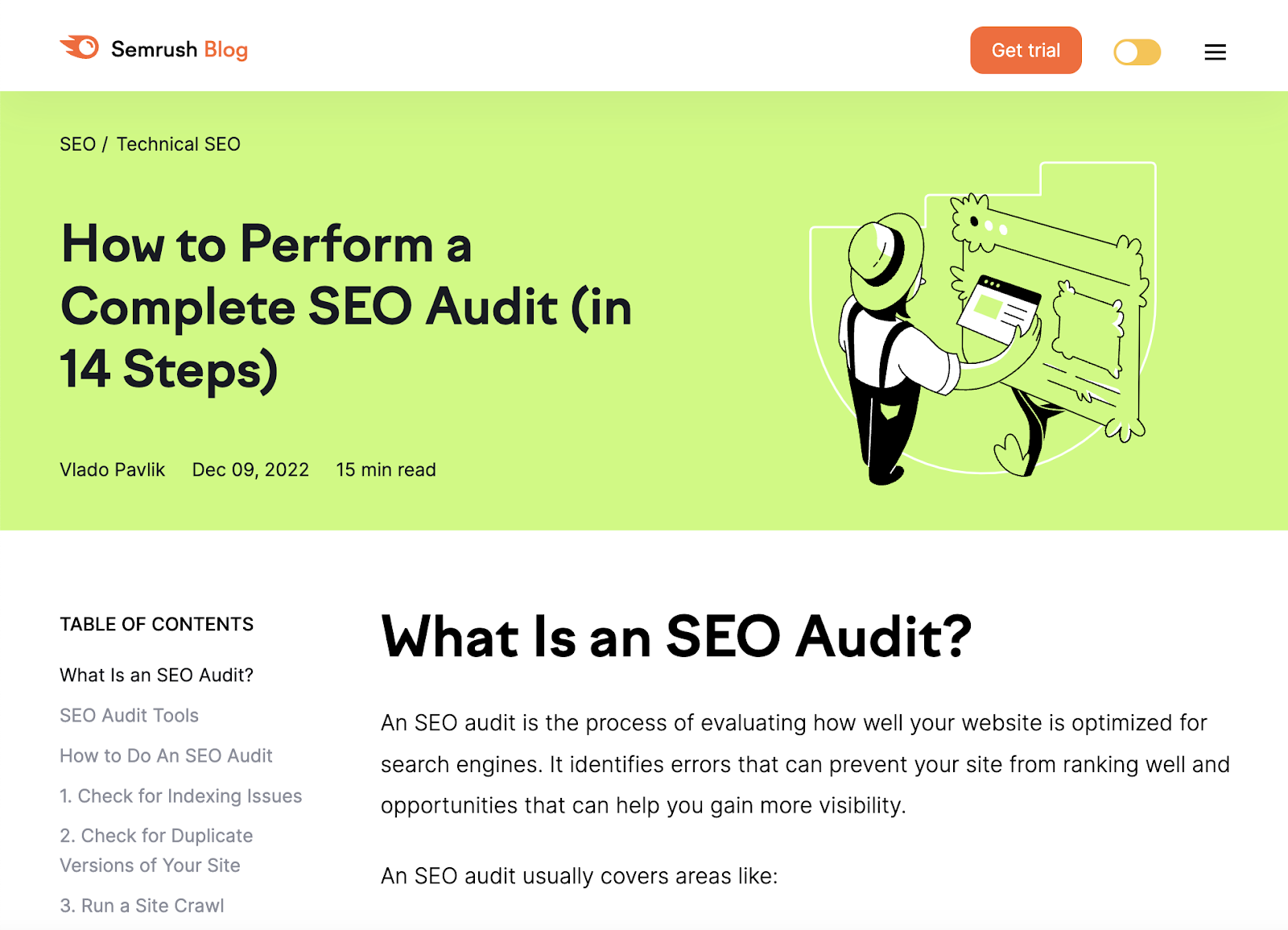
It currently gets 11.9K organic visitors (i.e., non-paid visitors) per month.

And ranks for 183 keywords.

Content marketing is an important digital marketing channel because it can help you provide value to your audience, influence their buying decisions, and improve your SEO performance.
How to Get Started with Content Marketing
Here are four steps you can follow to get started with content marketing:
Know Your Audience
The first step is to figure out who you’re creating content for.
You need to understand their problems, desires, questions, and preferences.
That way, you can create content they actually want to consume and share. This will inform everything you create.
How do you do that?
One simple way is to do market research and create buyer personas.
Start by opening One2Target. Add your domain and up to four competitor domains.
You’ll get insights into who you (and your competitors) are marketing to. And how they behave online.
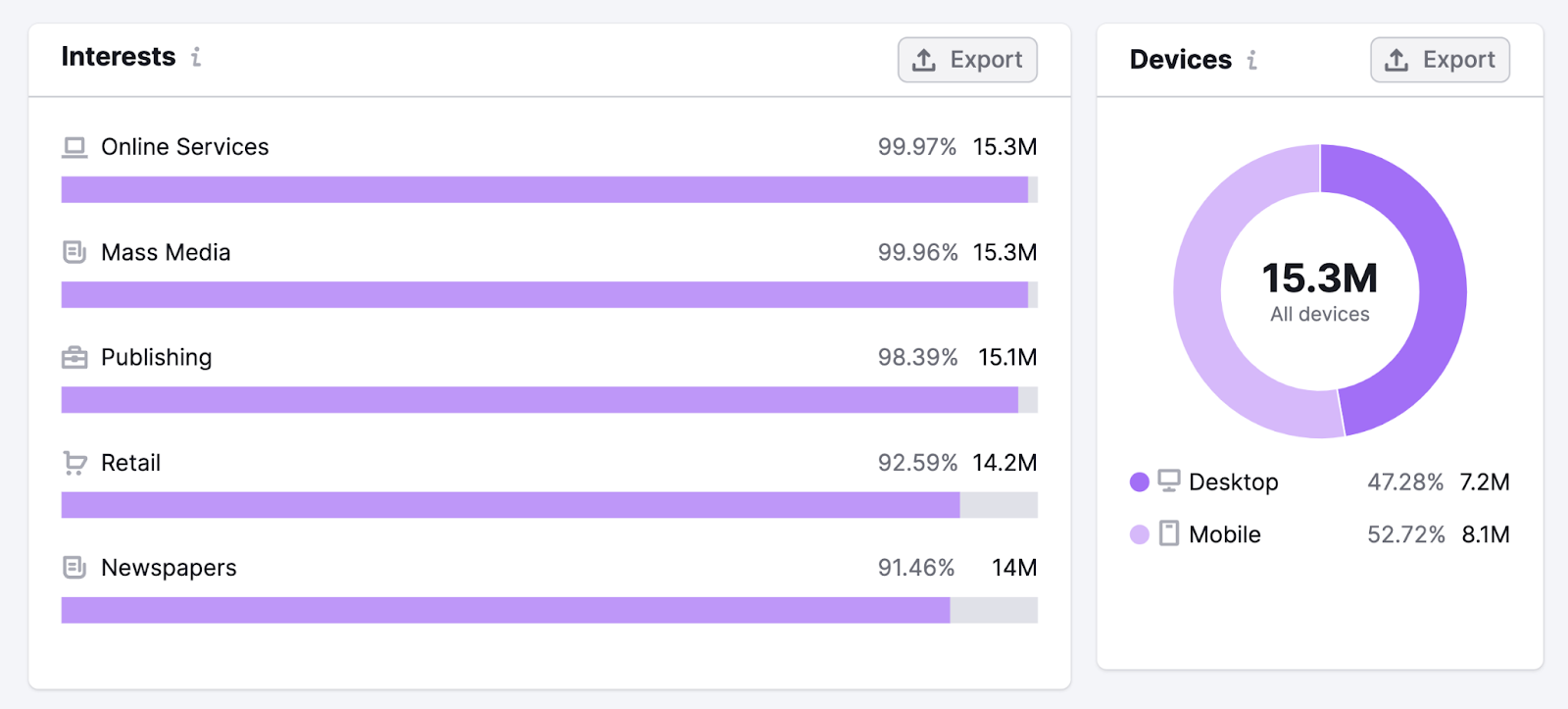
Then, based on your research, create buyer personas (fictional profiles of your ideal customers).
This will help everyone involved in creating content know who your content is meant to serve.
Further reading:
- How to Create Your Buyer Personas: the What, the Why, and the How
- Audience Research: What Is It & How to Do It
Find the Right Content Formats
The next step is to choose the best content formats for your audience and goals.
You can use tons of different formats:
- Blog posts
- Ebooks
- Infographics
- Videos
- Podcasts
- Webinars
- Case studies
The key is to find what types of content your audience prefers, consumes, and shares.
Here’s a quick and effective way to start:
Analyze your competitors’ top-performing pages.
Go to Organic Research, enter a competitor’s URL, and head to the “Pages” tab.
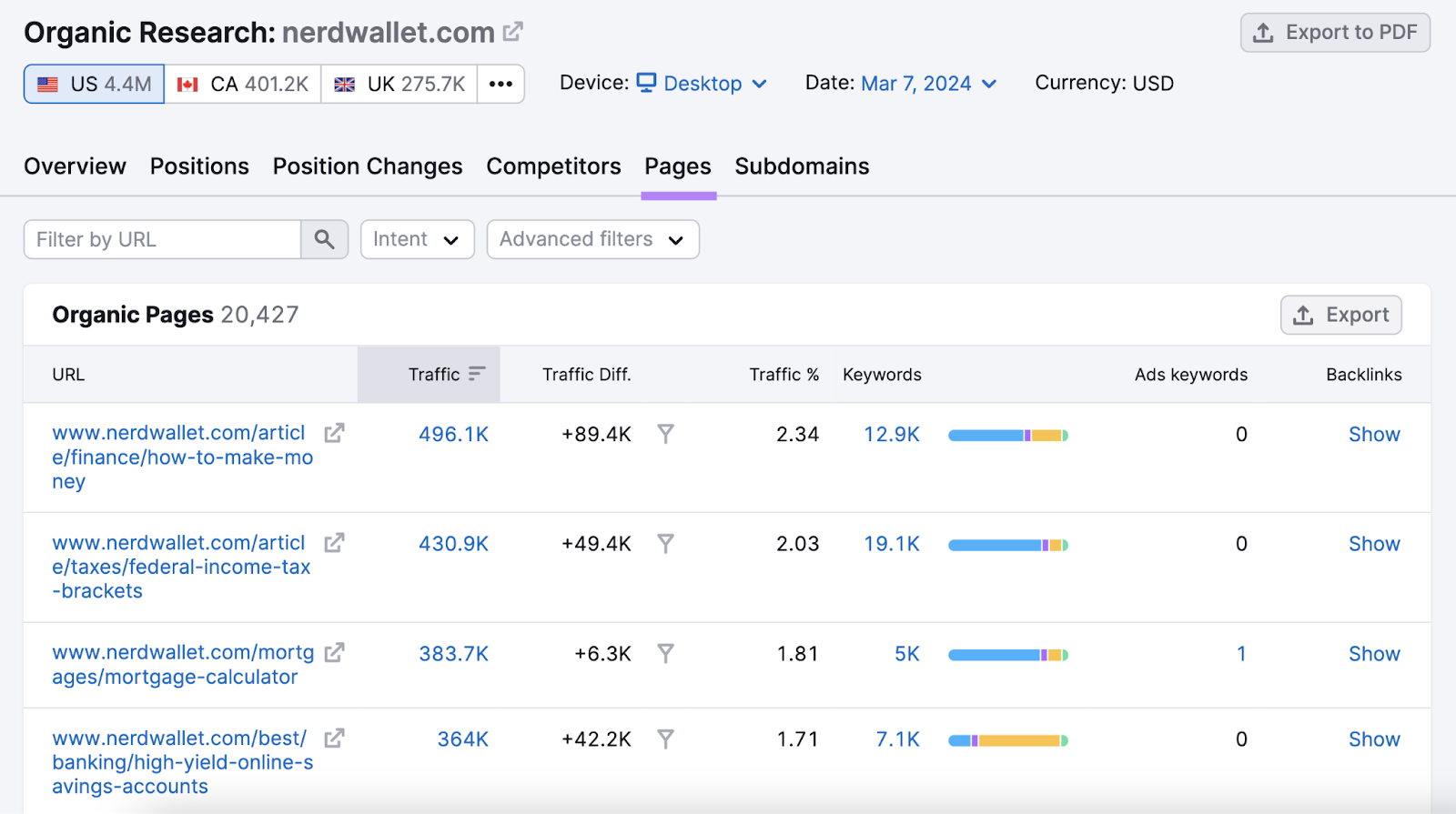
These are your competitor’s pages sorted by the amount of organic traffic they bring in.
Analyze the top pages carefully and try to look for patterns.
For example:
- Are they mostly blog posts, videos, product pages, or something different?
- Do they use lots of visual assets?
- Does the content tend to be long-form or short?
Use the answers to these questions to guide your content production. Recreate what’s already working in a better way.
Then, repeat this process for at least three to five of your top competitors. And you should have a pretty good idea of which content formats to focus on.
Further reading: 12 Types of Content Marketing to Leverage for Success
Research Topic Ideas
The next step is to brainstorm content ideas your audience may be interested in.
You want to find topics that are relevant, popular, and profitable.
How?
Start by entering a broad topic into Topic Research. You’ll get tons of ideas based on what people are actively searching for.
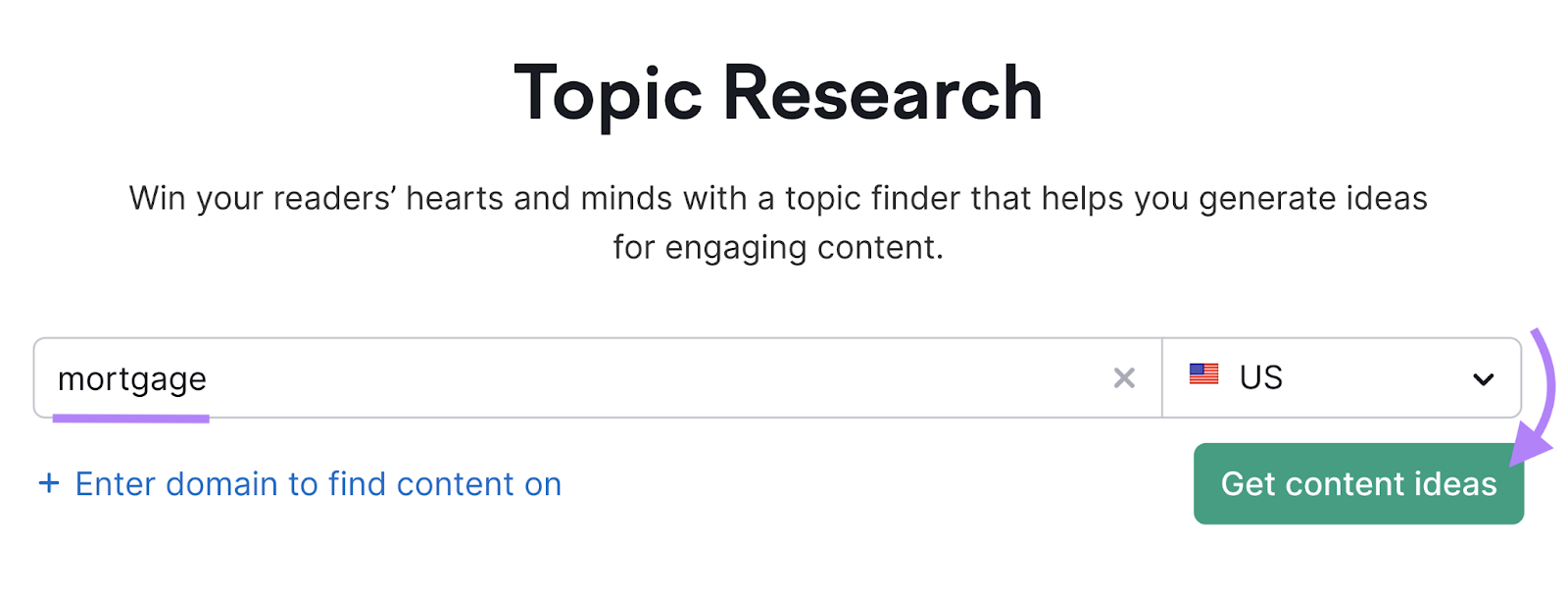
Click “Show more” on any subtopic to see popular headlines, questions, and related searches.
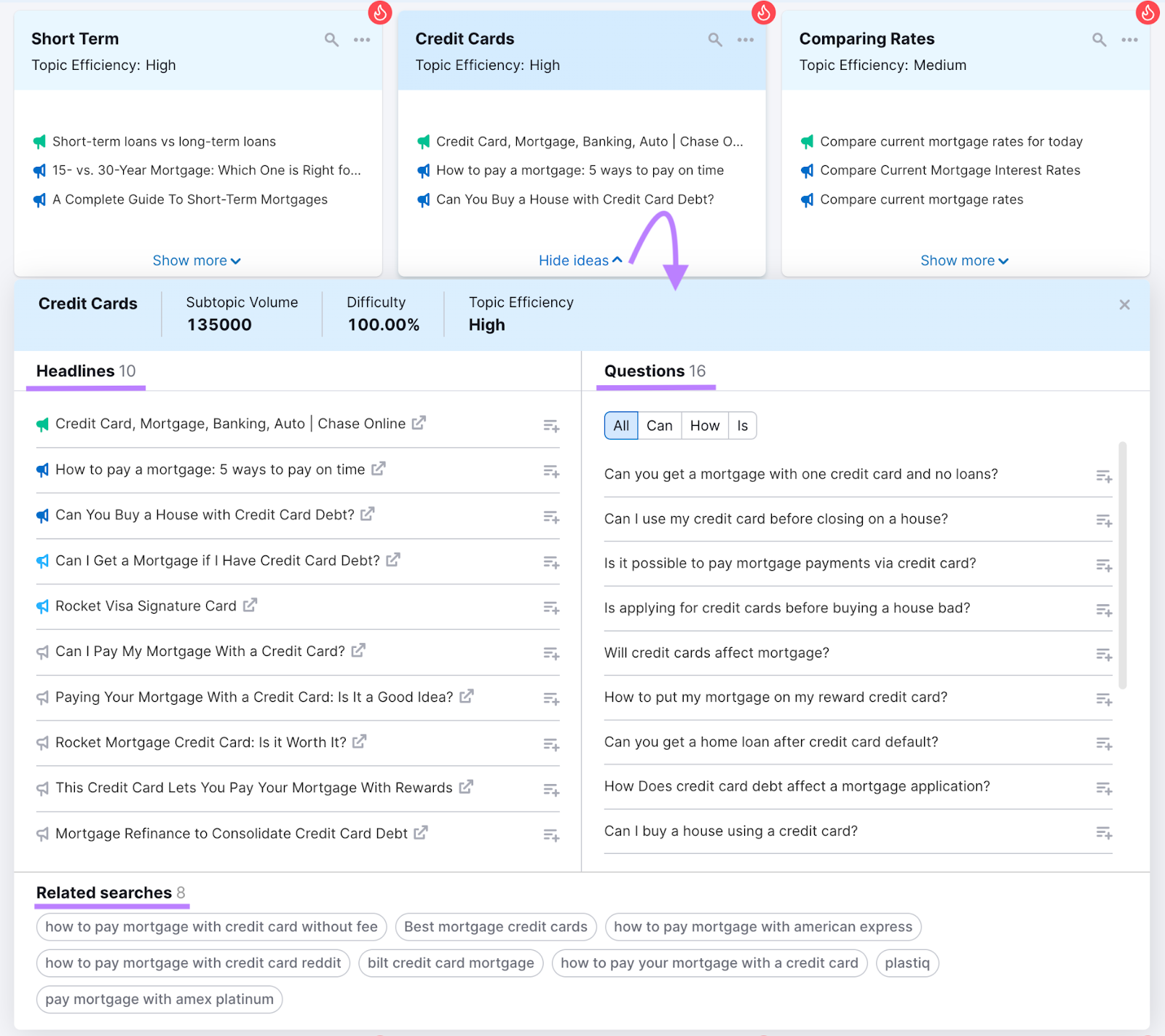
Further reading: 121 Blog Ideas and Topics to Write About
Write and Optimize Your Content
The third step is to write amazing content your audience will love. And optimize it so it ranks well on search engines.
You should write content that is clear, concise, accurate, informative, and persuasive.
And you also need to make sure your content is easy to find, read, and share.
Here’s how:
Use a tool like the SEO Writing Assistant.
It’ll quickly scan your content and provide quick tips on how to improve readability, originality, tone of voice, and SEO.
Like this:
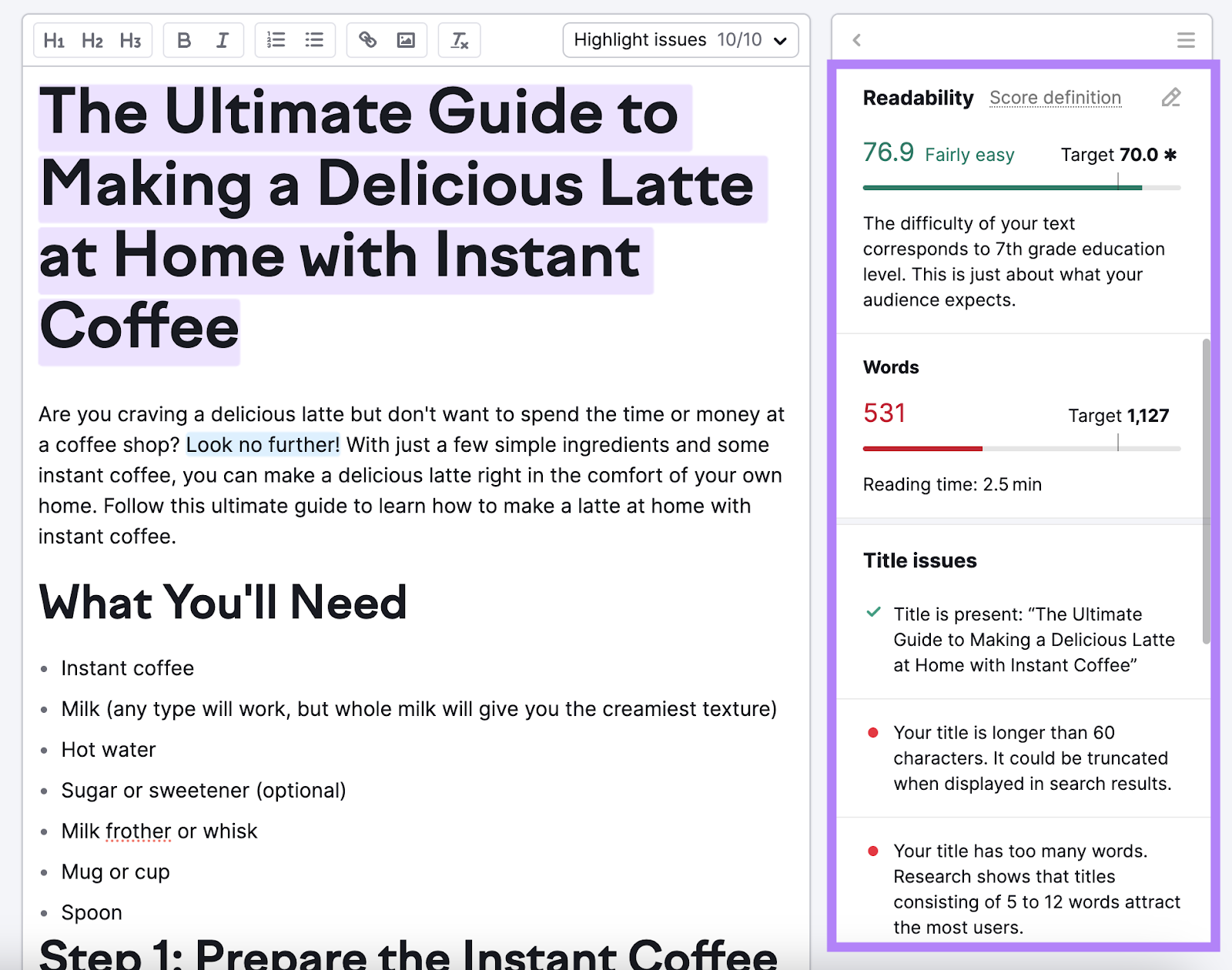
Further reading: What Is Quality Content & How to Create It
4. Social Media Marketing
Social media marketing is all about using social media platforms—like Facebook, X (formerly Twitter), Instagram, and LinkedIn—to promote your brand, products, or services.
For example, Semrush repurposes blog content and shares it on LinkedIn. Like this:
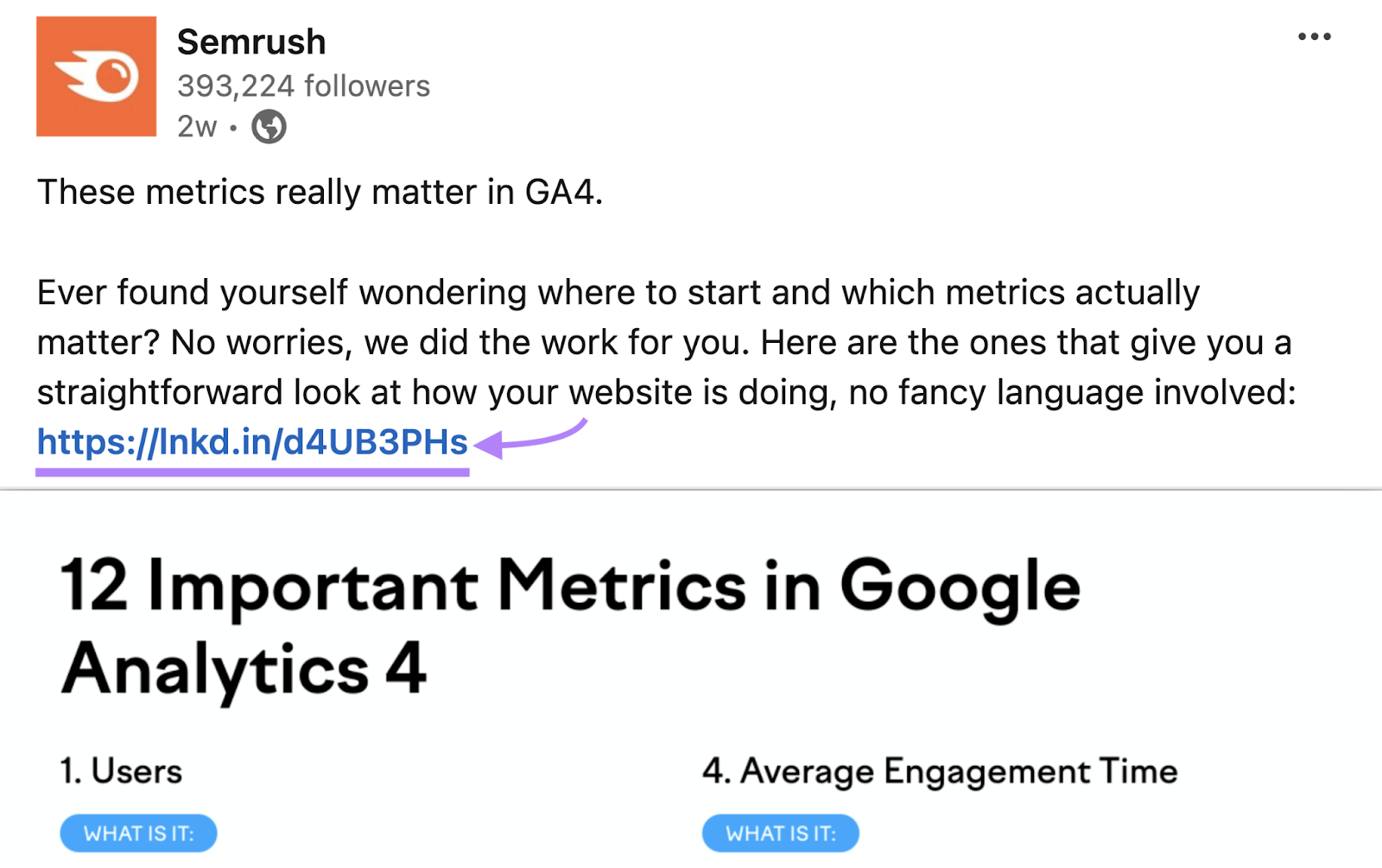
Which is why around 20% of traffic to that blog post comes from organic social media.

Social media is an important digital marketing channel because it can help you:
- Reach millions of potential customers who use social media every day
- Connect and interact with your target audience by sharing valuable and engaging content
- Build trust and loyalty by showing your brand personality and customer service
- Learn from your competitors by spying on their strategies and results
- Stay on top of the latest trends and changes in your industry and customer behavior
How to Get Started with Social Media
Here are a few steps and questions to get you started with social media marketing:
- Define goals and objectives. What do you want to achieve with social media marketing? How will you measure success?
- Identify your target audience. Who are they? Where are they? What are they looking for? How can you help them?
- Choose the right platforms. Which social media platforms are best for your brand and audience? What are their features, benefits, and challenges?
Use Social Tracker to see which platforms competitors are focusing on, are driving the most engagement, and are growing the fastest.
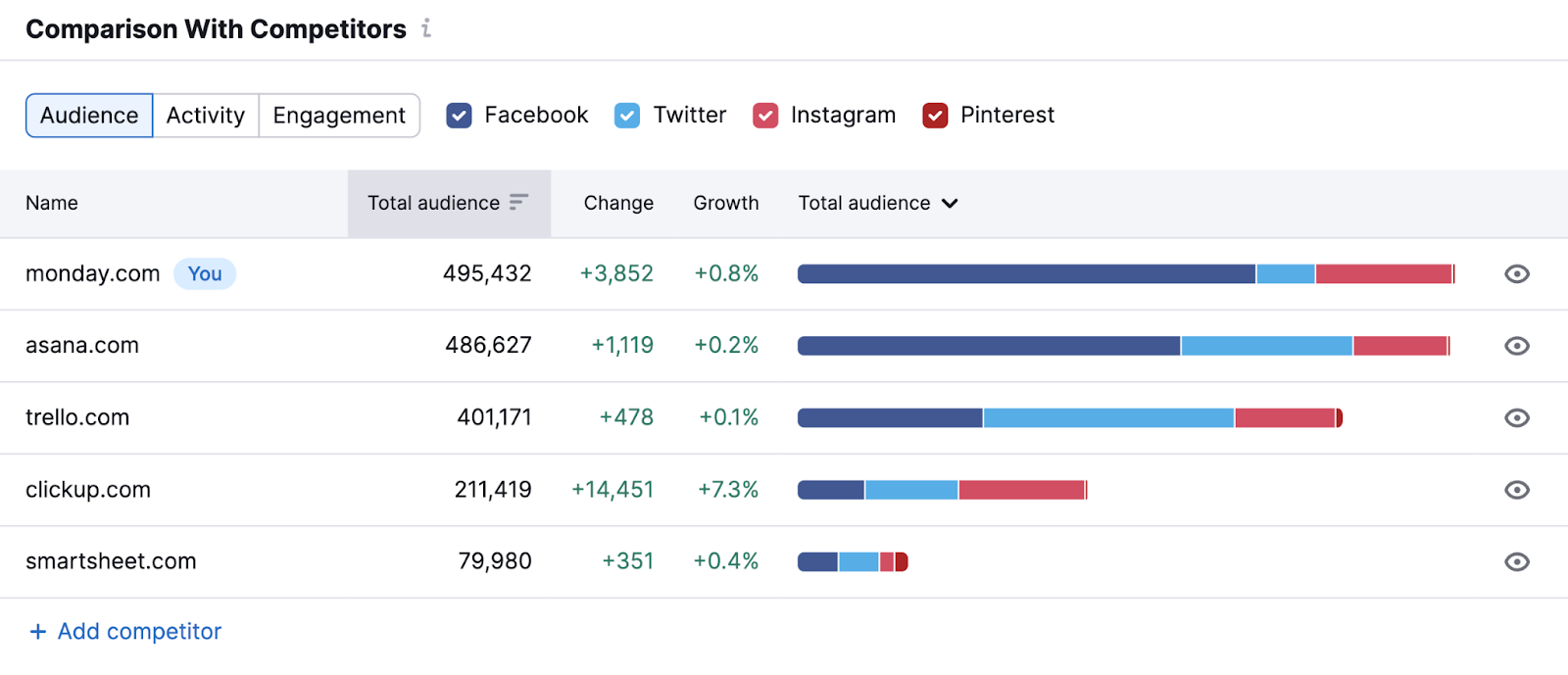
- Create and optimize profiles. How will you present your brand on social media? What are the best practices for creating and optimizing your profiles?
- Plan and create content. What type of content will you create and share on social media? How will you align it with your goals, audience, and platforms? How will you make it engaging, relevant, and consistent?
- Schedule and publish your posts. When and how often will you post on social media? How will you use tools and automation to save time and optimize your results?
Use a tool like Social Poster to find the best time to schedule your posts on all your social profiles.
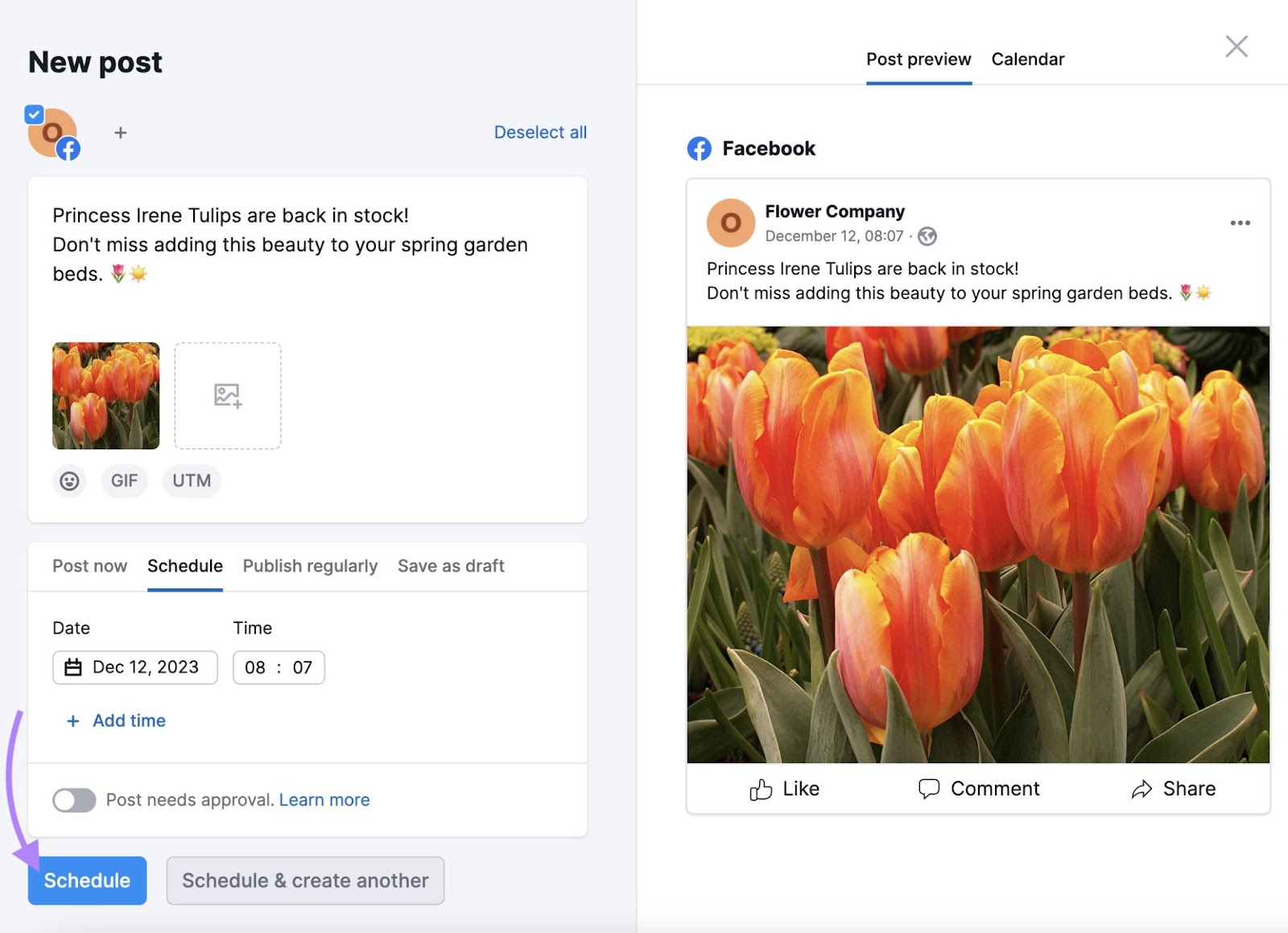
- Engage and communicate with your audience. How will you respond to comments, messages, mentions, and reviews? How will you encourage and reward engagement and feedback?
Leverate tools like Social Inbox so you can consolidate (and reply to) all comments, messages, and mentions in one simple inbox.
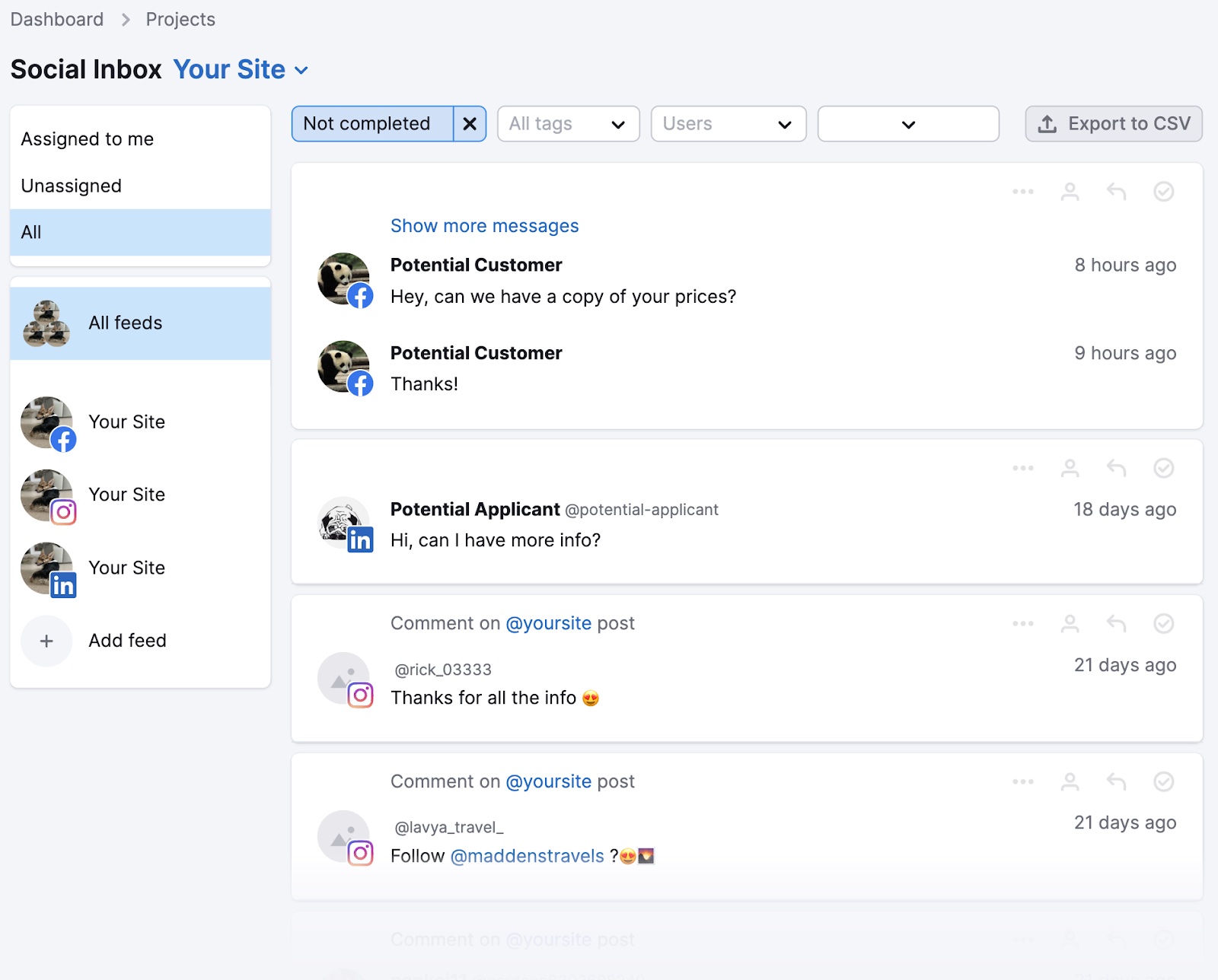
- Analyze and improve your strategy. How will you track and evaluate social media performance? What tools and metrics will you use? How will you identify and implement improvements and best practices?
A tool like Social Analytics can help you see and track analytic metrics for Facebook, Instagram, and LinkedIn in one view.
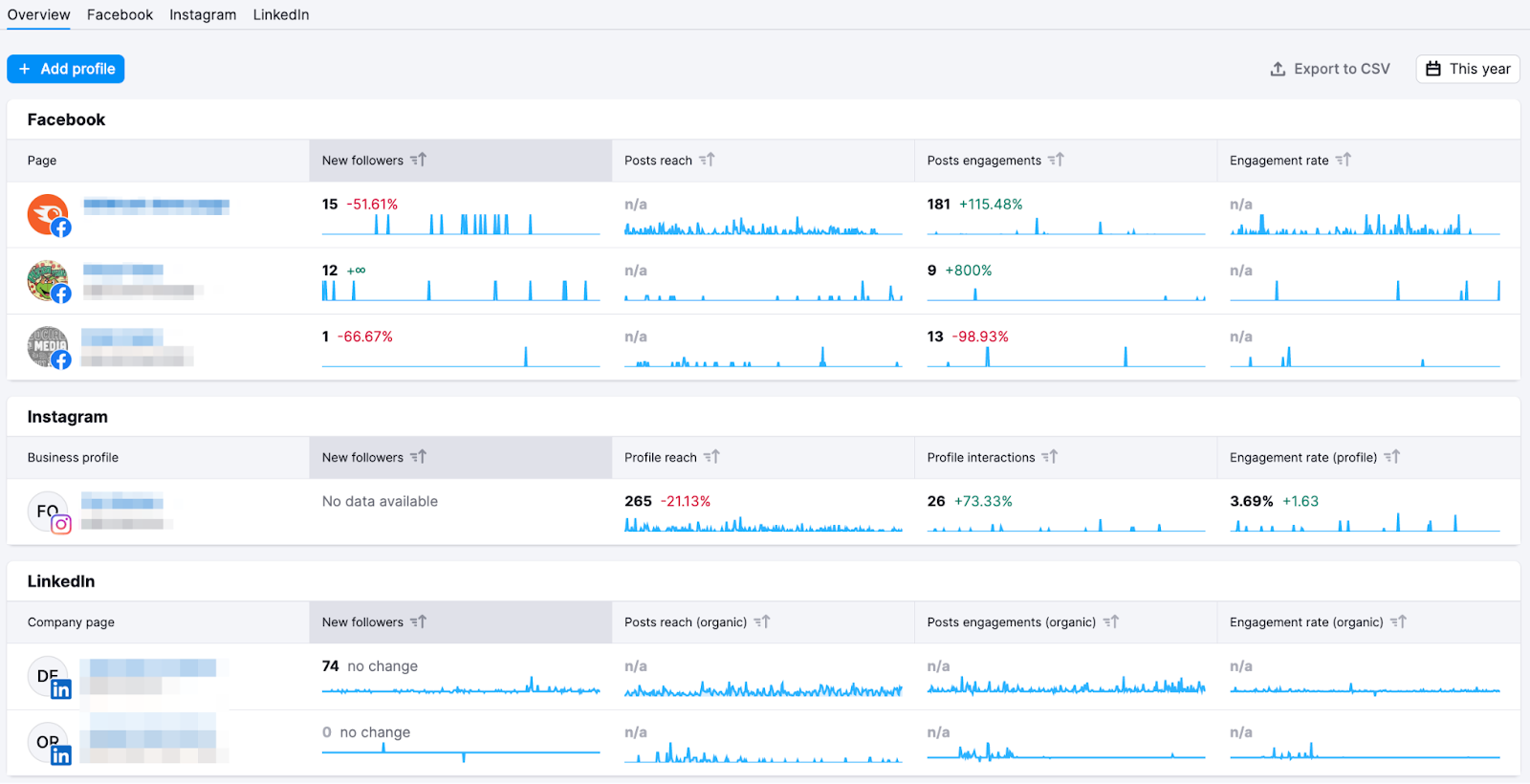
Further reading: Social Media Management: The Ultimate Guide
5. Email Marketing
Email marketing is the process of sending targeted messages to your audience via email. And it’s a very effective digital marketing channel.
Why?
Because email marketing lets you connect with customers and prospects in a personal, timely, and affordable way.
For example, Monos emails their customers when they’ve left something in their cart. The email includes the customer’s name and the specific item they expressed interest in.

This encourages potential customers to hit that checkout button on the purchase page.
With email marketing, you can:
- Build trust and loyalty with subscribers
- Boost brand awareness and authority
- Drive more traffic to your site or landing page
- Generate more leads and sales
- Nurture and retain existing customers
- Promote new products or services
- Get feedback and reviews from customers
And more.
How to Get Started with Email Marketing
Here are a few steps you can follow if you want to get started with email marketing:
First, create an email marketing strategy. By defining your goals and learning more about your target market.
Some common email marketing goals are driving sales, increasing customer loyalty, and encouraging repeat purchases.
Then, choose some tools to help you through the email marketing process. ConvertKit, for instance, is a great email marketing platform for both individual creators and bigger teams
Next, create your email campaigns and editorial calendar. Like this:
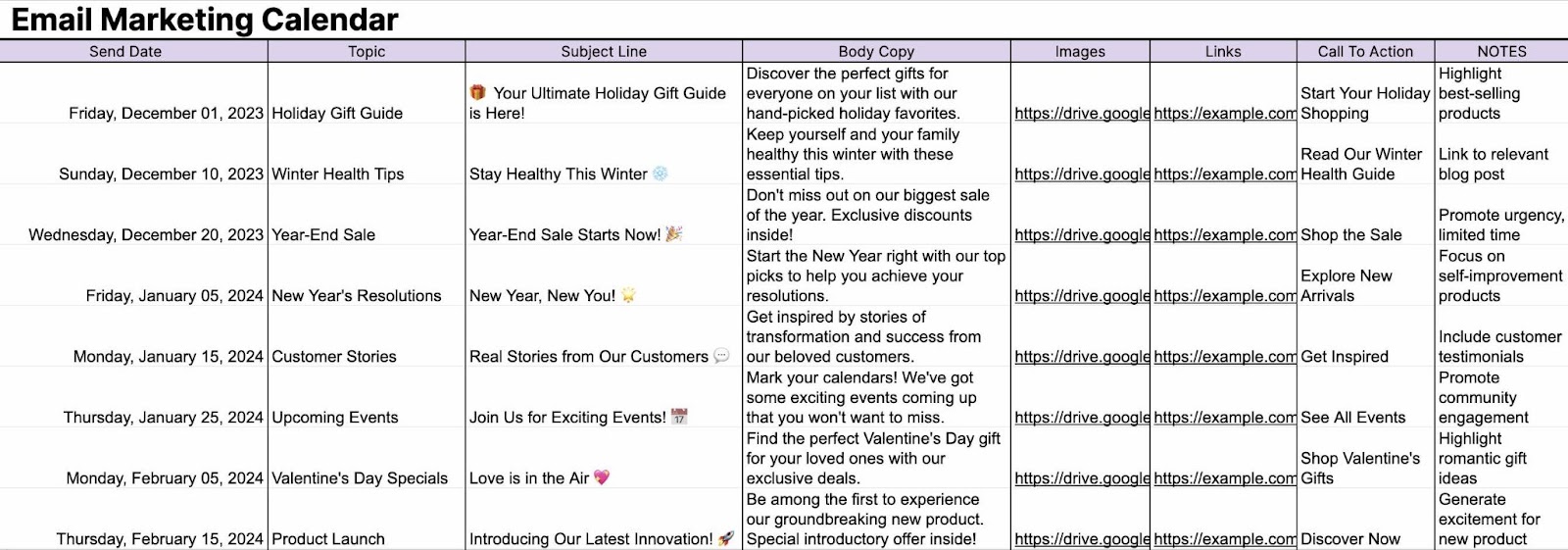
Lastly, regularly check your email marketing platform’s reports page to see how your email campaigns are performing.
Use the data to learn about how you can improve your campaigns. And better engage with your audience.
Email marketing is a powerful and flexible digital marketing channel that can help you grow your business and reach your target audience.
Further reading:
- How to Get Started with Email Marketing in 6 Easy Steps
- Engage & Convert: The Ultimate Email Marketing Guide
6. Paid Advertising
Paid advertising is a type of digital marketing channel that involves paying to display ads to a targeted audience on different online platforms.
Here is what paid ads look like on Google.
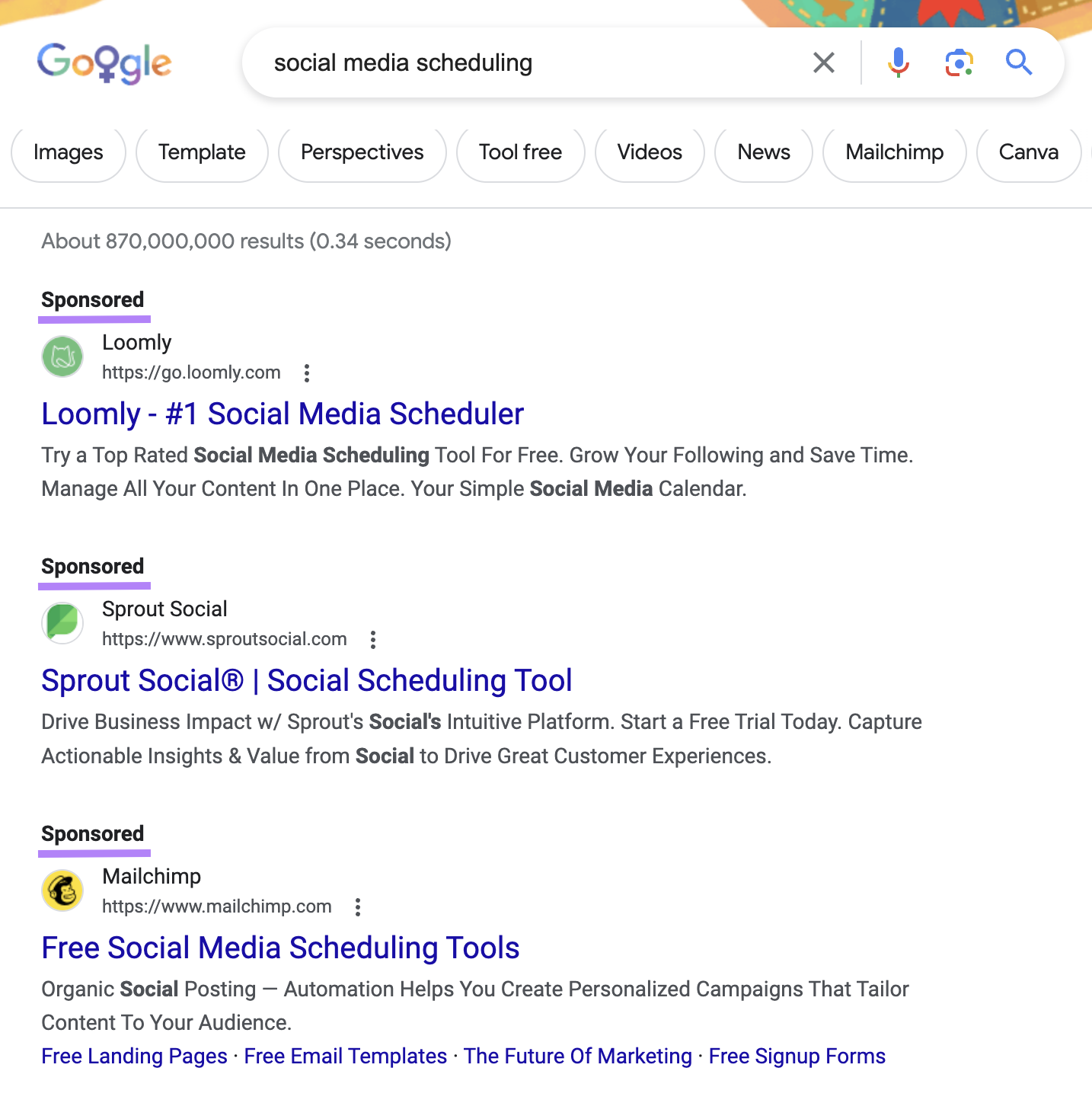
Companies pay to show up first on the search results page for relevant keywords. Which is why there’s a “Sponsored” tag above each ad.
Two common paid ad models are pay-per-click (PPC) and cost per impression (CPM). Both can be cost effective since you only pay every time someone clicks on or sees your ad.
Unlike organic marketing, where you create content and optimize your site for search engines, paid advertising lets you reach potential customers faster and more directly.
Among many other things, paid advertising is important because it can help you:
- Drive more highly targeted traffic to specific pages
- Test and optimize your marketing messages and offers
- Target specific audience segments based on demographics, interests, behaviors, and locations
- Retarget people who visited your site but didn’t take action
- Track and measure your return on investment (ROI) and performance
How to Get Started with Paid Ads
To get started with paid advertising, first choose the platforms that match your goals, budget, and audience.
One of the most popular is Google Ads.
It lets you show your ads on Google’s search results, as well as on millions of websites that are part of the Google Display Network.
Which means your ads can appear on websites like this:
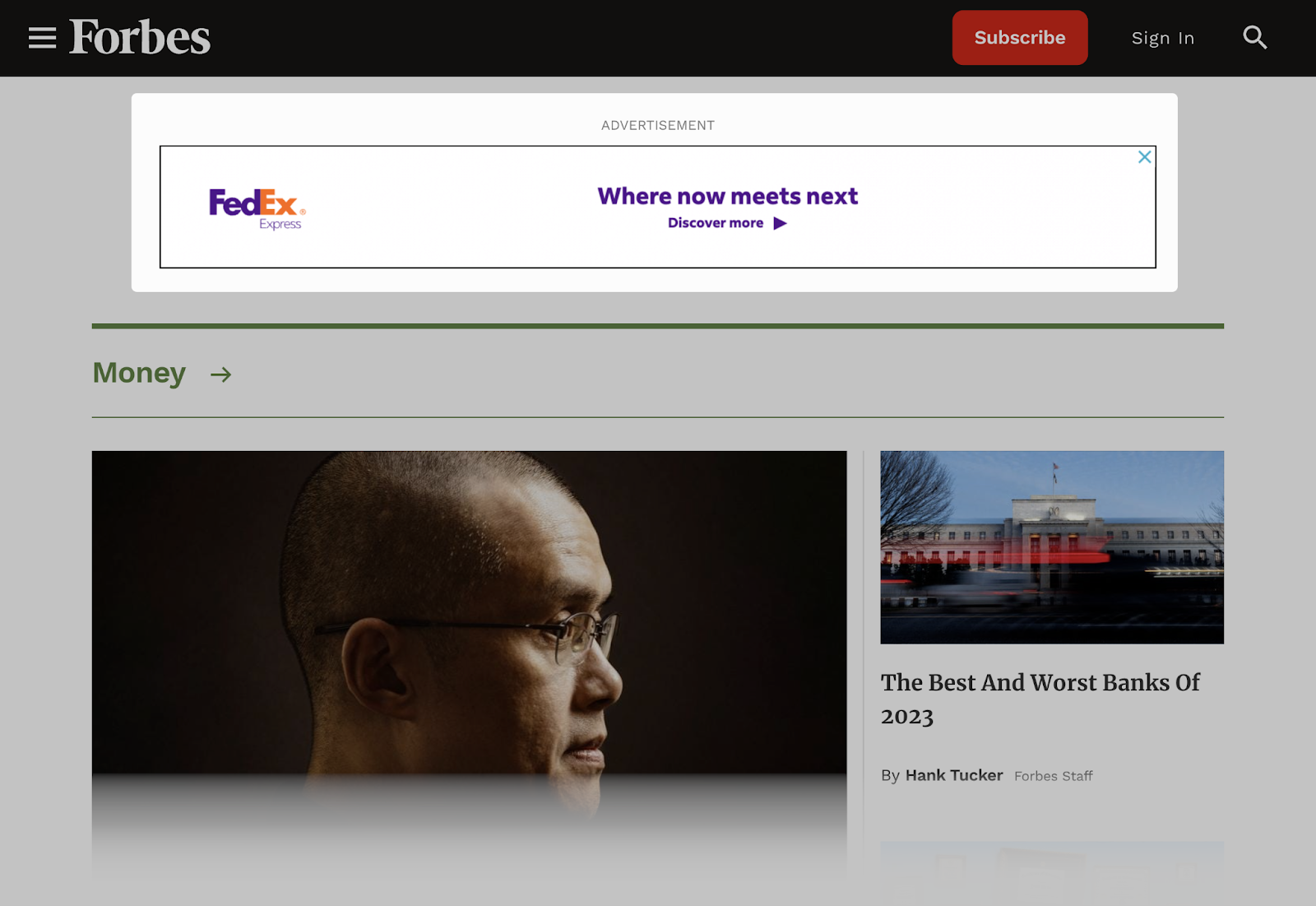
Plus, you can also use Google Ads to create video ads on YouTube, shopping ads on Google Shopping, and app ads on Google Play.
Other paid advertising platforms include Facebook Ads, Instagram Ads, LinkedIn Ads, and X Ads.
Once you know where you want to run ads, do a bit of competitive research. Especially for Google Ads.
Open Advertising Research, enter a competitor’s domain, and click “Search.”
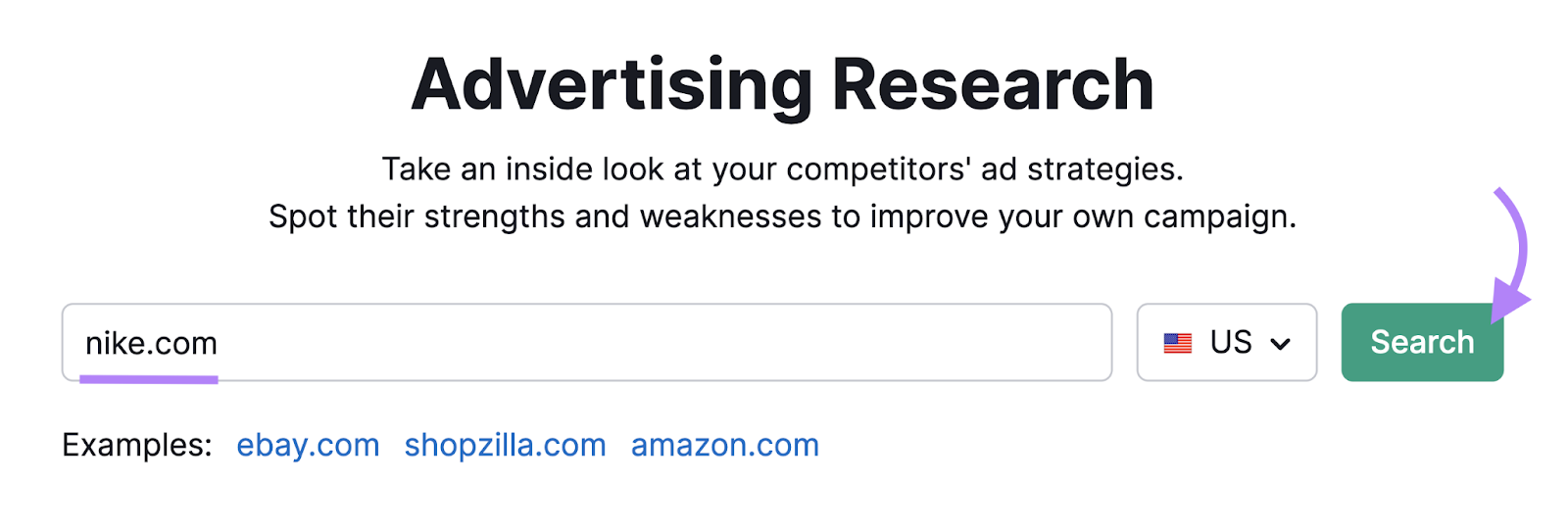
The “Positions” tab will show the keywords they’re bidding on and the target URLs.

Click the “Ad Copies” tab. You’ll see the exact ads they’re running. And the keywords that trigger those ads.
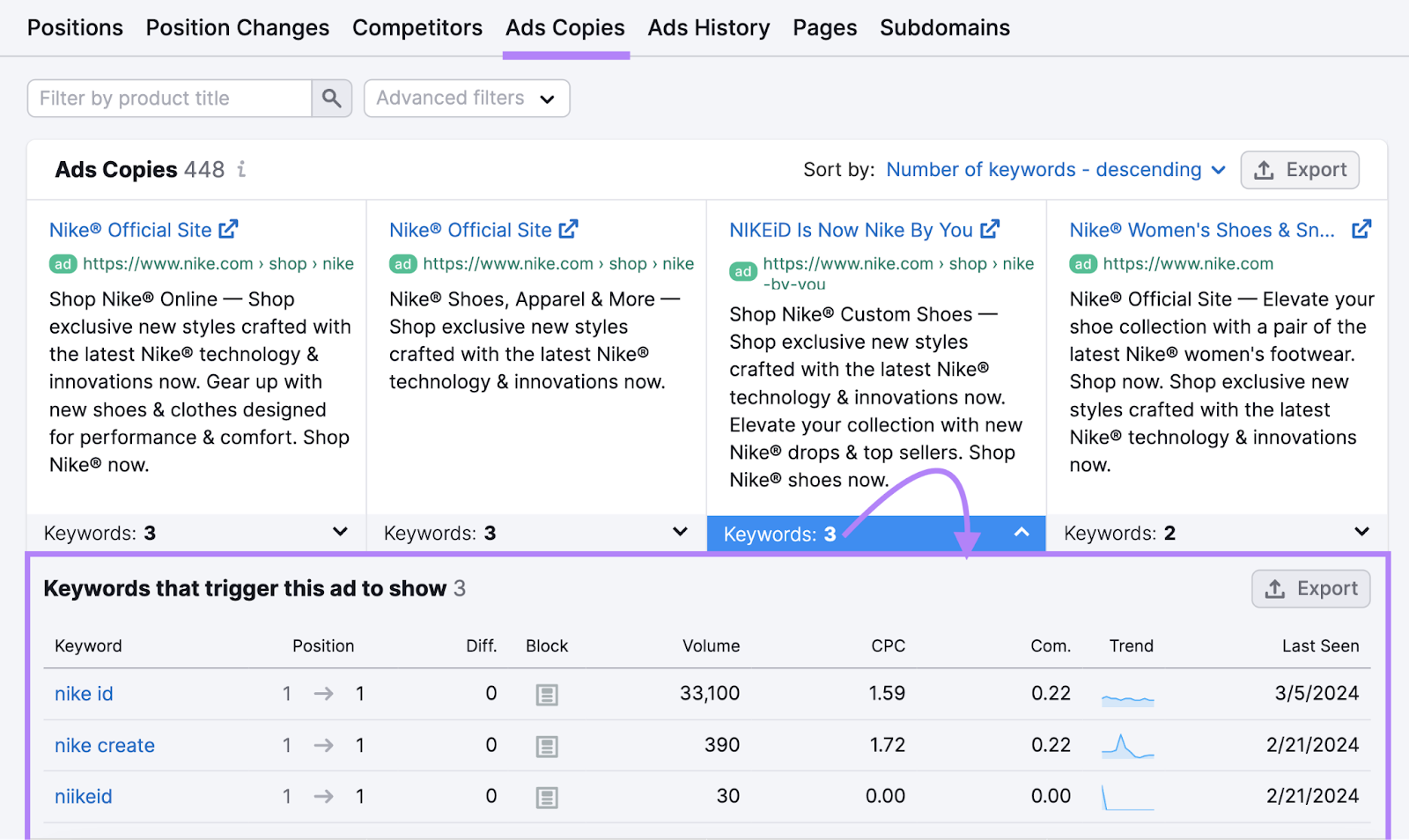
Then, you can head to the “Competitors” tab to discover new rivals.
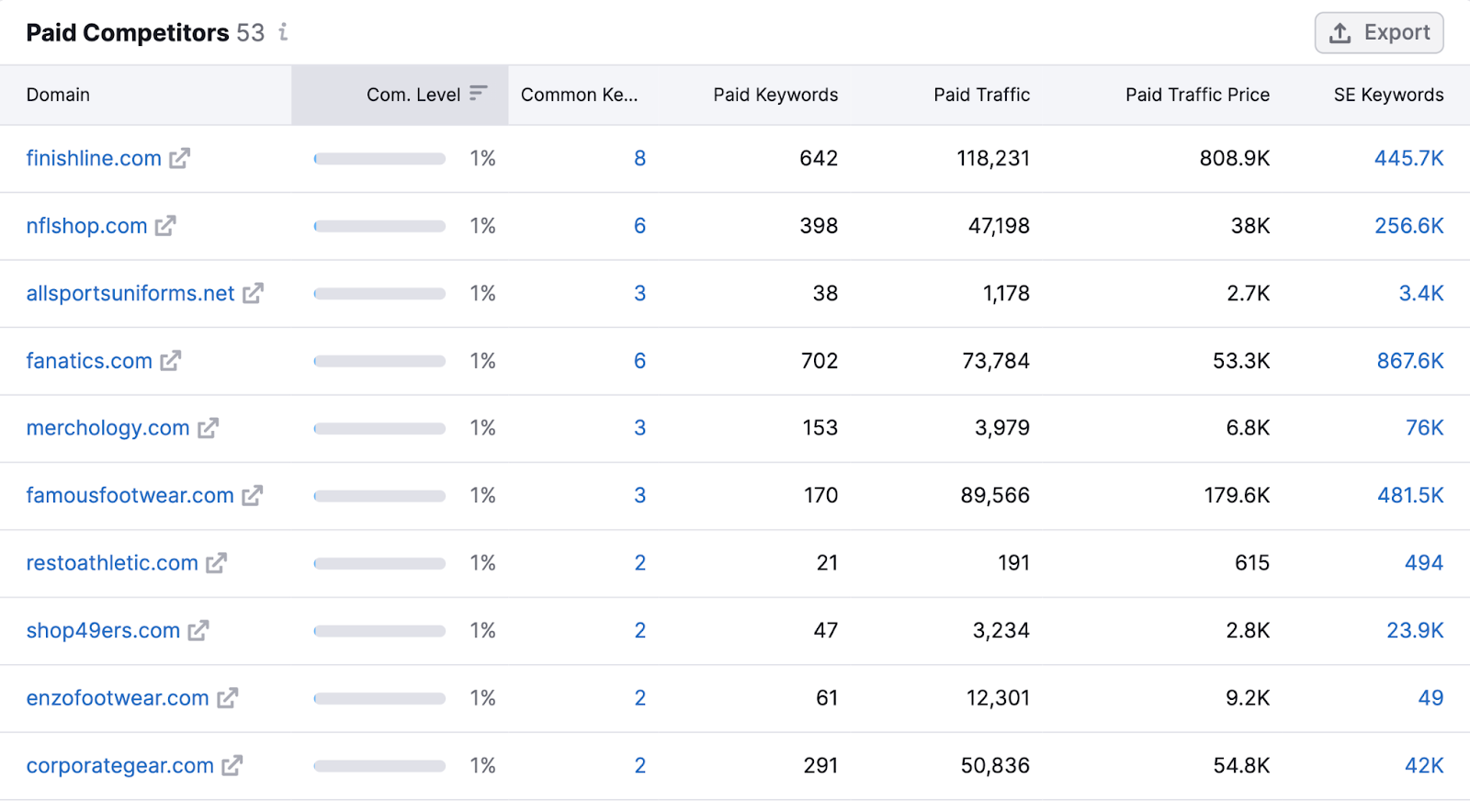
Repeat this tactic for each of your main competitors. And use the insights to get more out of your marketing efforts.
Finally, create your ad.
You can use Canva to create the image for your ad. Or use AdCreative.ai to generate one with AI.

And then either write the copy manually or get help from AI with the free Social Media Post Generator.
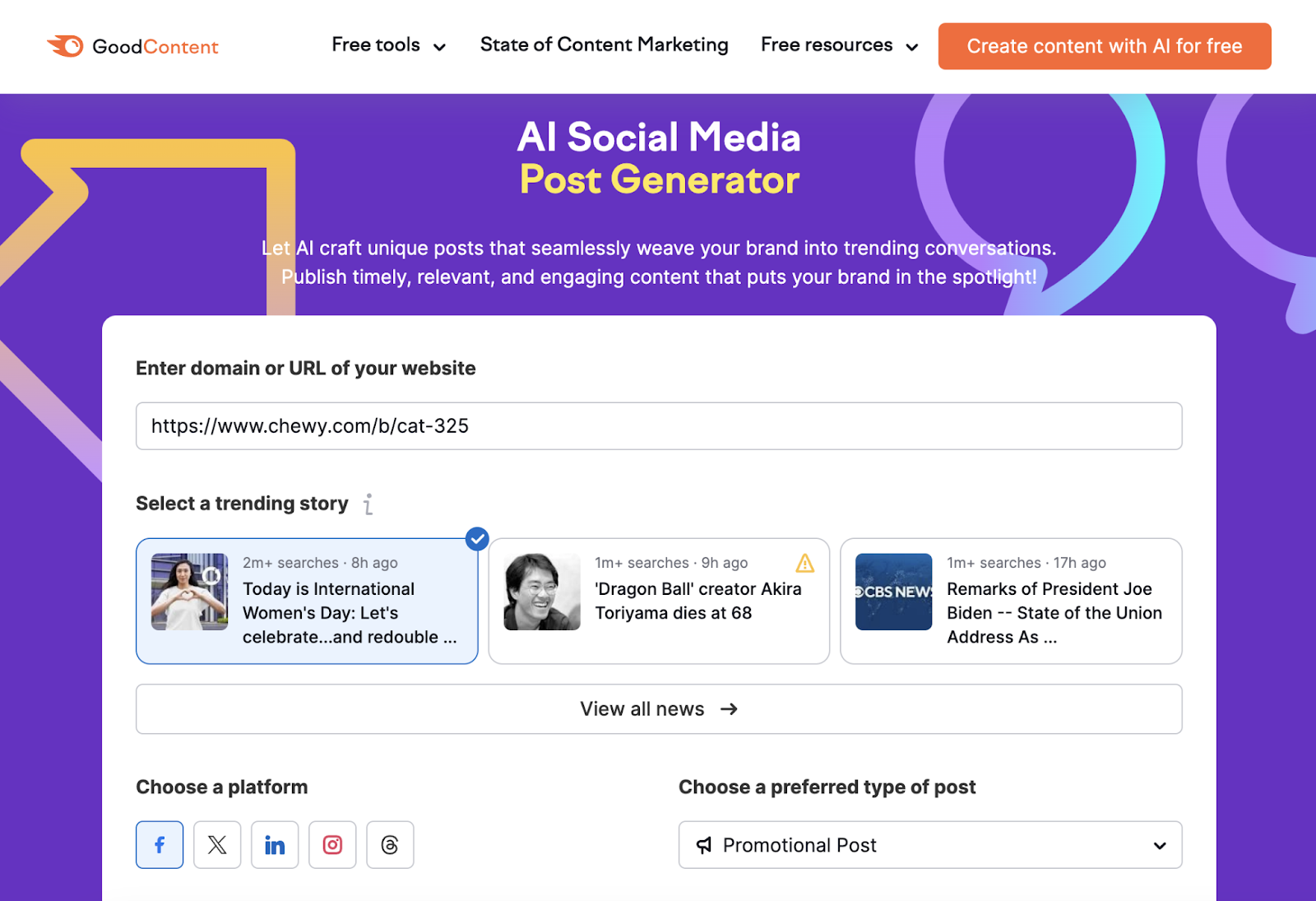
Get more in-depth knowledge about paid ads by checking out Sermrush’s guides (listed below).
Further reading:
7. Video Marketing
Video marketing is using video content to promote your brand, product, or service. It can help you educate customers, increase engagement, boost conversions, and reach decision-makers faster.
And it’s one of the most effective digital marketing channels.
Why?
Because it’s multi-sensory and emotionally engaging. Meaning it can capture attention and convey information better than text or images.
For example, DJI introduces new products on YouTube. And gets thousands to over a million views on their videos.
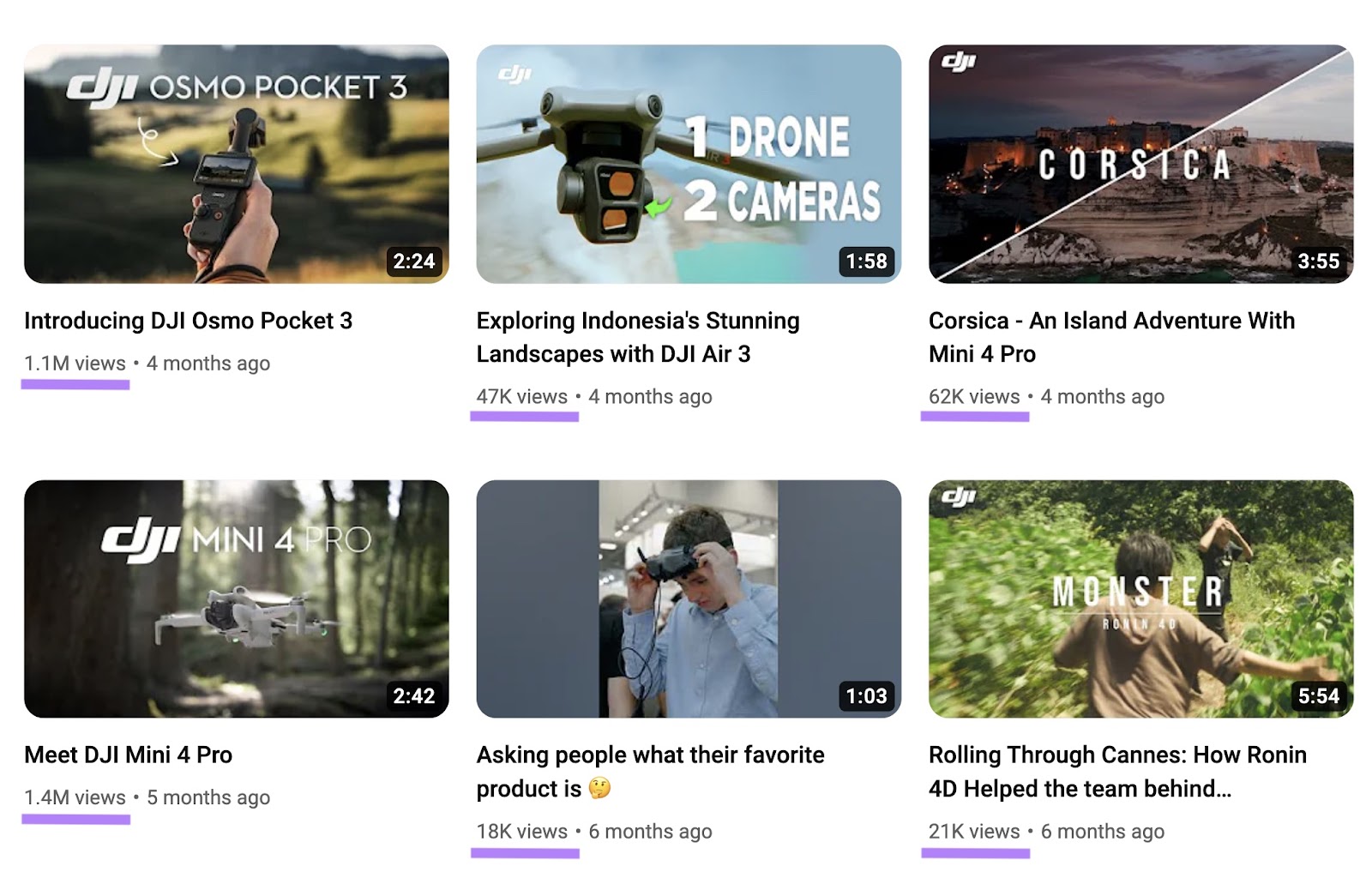
Which can equate to tons of potential customers.
How to Start Reaching Customers with Video Marketing
To start with video marketing, you need to have a clear goal, a defined audience, and a compelling story.
You also need to choose the right type of video for your purpose, such as explainer videos, testimonial videos, live videos, or sponsored videos.
You can have videos on your website, but you can also share them on the platforms where your audience is, such as YouTube, Facebook, Instagram, or TikTok.
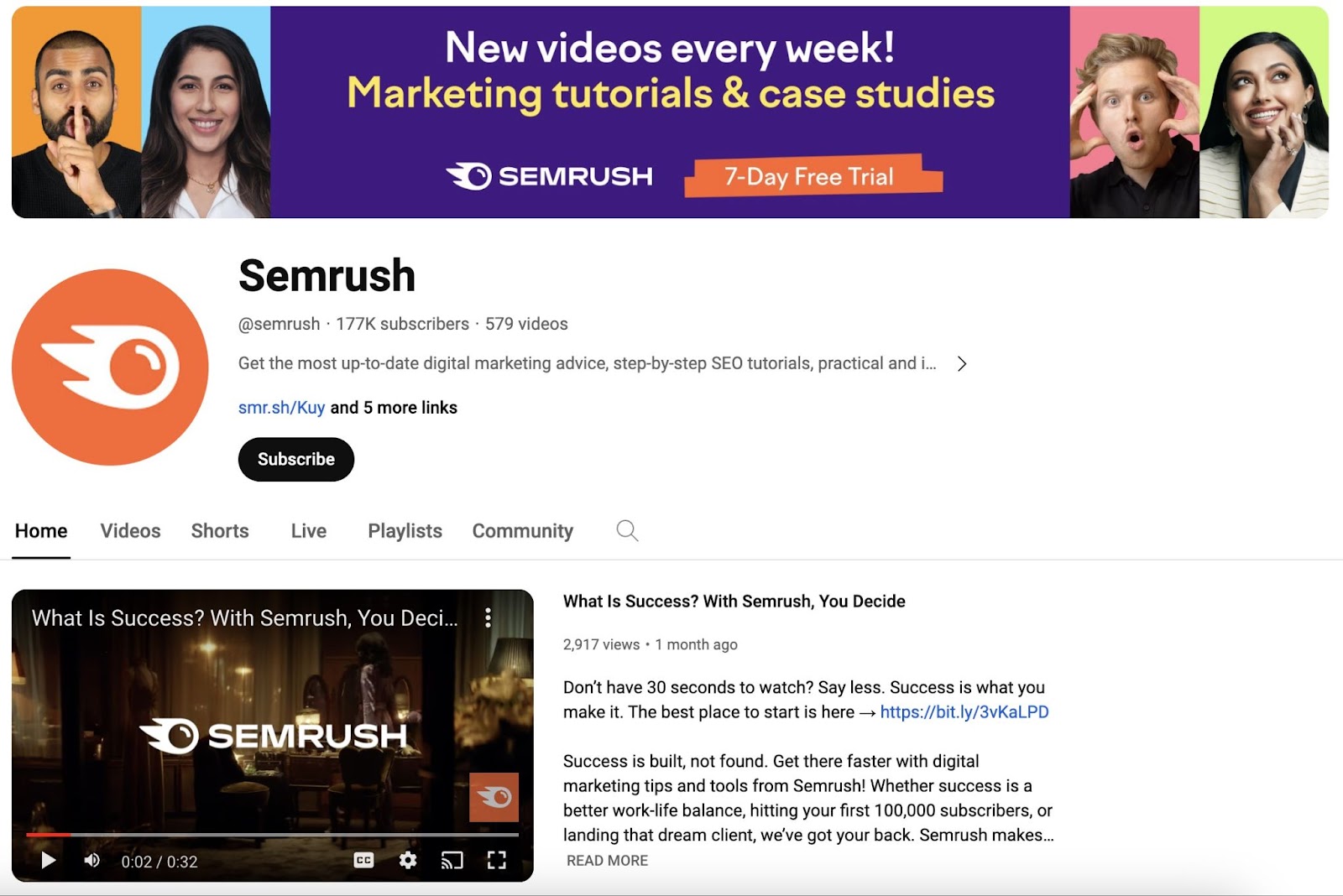
And finally, you need to measure your video performance and optimize your strategy based on the results.
Here are some tips to make your video marketing more effective:
- Hook your audience in the first few seconds with a catchy title, thumbnail, and introduction
- Tell stories that connect with your audience and showcase your personality, values, and benefits
- Evoke positive emotions and inspire action
- Make your videos “sticky” by adding elements of surprise, curiosity, or humor
- Rely on visuals and soundtracks to enhance your message and appeal to different senses
- Keep your videos concise, clear, and relevant to your goal and audience
Video marketing is a powerful way to grow your brand and business in 2024 and beyond.
By following these steps and tips, you can create engaging and effective video content that can help you reach more customers and drive more business.
Further reading: Video SEO: How to Get Your Videos to Rank
8. Referral Marketing
Referral marketing is a strategy that encourages existing customers to recommend your products or services to their friends, family, or contacts.
Here’s an example.
When PayPal first started, they relied on referrals to achieve a 7% to 10% daily growth rate.
PayPal paid happy customers to invite their friends to try PayPal out. And handed out monetary rewards for successful referrals.
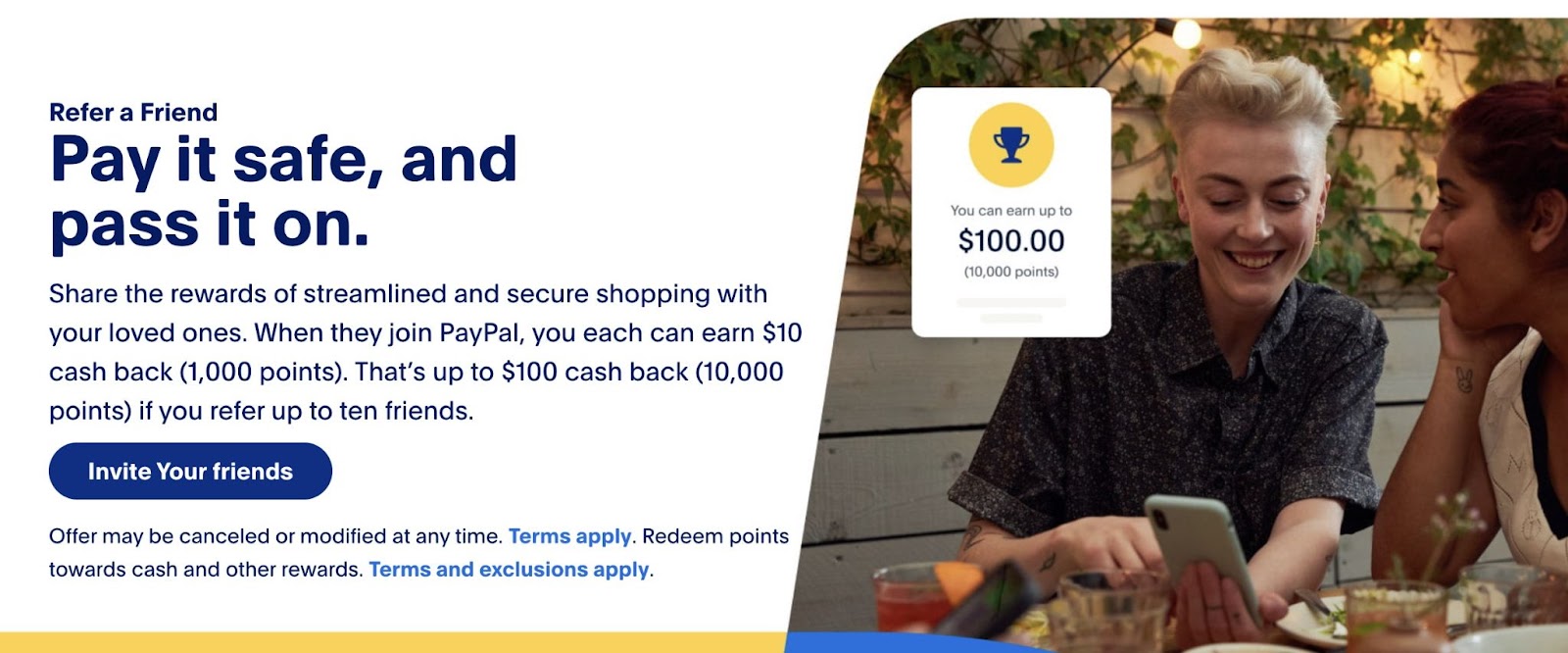
Referral marketing capitalizes on word of mouth and trust—converting happy customers into brand ambassadors.
And can significantly lower customer acquisition costs while boosting credibility and customer loyalty.
How to Get Started with Referral Marketing
To start reaching customers with referral marketing, follow these steps:
- Find your best customers and advocates. These are the people who love your product or service, have a large or relevant network, and are willing to share their experiences with others. You can use surveys, feedback forms, reviews, or social media to find them.
- Create a referral program. Create a program that is easy to use, attractive, and rewarding for both the referrer and the referred. You can use tools like Impact or PartnerStack to create and manage your program. Then, decide the incentives you’ll offer, such as discounts, free products, cash, etc.
- Promote your program and ask for referrals. Make your referral program visible and accessible to your customers. And remind them of the benefits. You can use email, social media, your website, or other channels to promote your program. Use testimonials, case studies, or stories to show how your referral program works and how it helps.
- Track and improve your referral program performance. Monitor and analyze your program’s results, such as the number of referrals, conversions, revenue, and ROI. Use feedback and data to optimize and improve your referral program over time.
9. Affiliate Marketing
Affiliate marketing is when you partner with other websites, influencers, or content creators and pay them a commission for every sale or action they generate for you.
It’s a win-win situation:
You get more exposure, traffic, and sales. And your affiliates get paid for promoting your products or services.
Here is Semrush’s affiliate program:

Affiliate marketing is one of the best digital marketing channels.
Here’s why:
- You can tap into your affiliates’ existing audiences. And reach more people who are interested in your niche or industry.
- You can boost brand trust and authority. By getting endorsed or recommended by reputable affiliates who have influence and expertise in your niche or industry.
- You can save money and time on marketing. By paying your affiliates only when they deliver results. And by using their existing content and platforms to promote your products or services.
- You can improve your SEO and ranking. By getting quality backlinks from your affiliates’ websites. Which can increase your domain authority and organic traffic.
How to Start with Affiliate Marketing
To get started with affiliate marketing, first define your goals and target market.
What do you want to achieve with your affiliate program? And who do you want to reach with your products or services?
Then, you need to find and recruit your ideal affiliates.
Who are the best websites, influencers, or content creators to partner with? And how can you convince them to join your affiliate program?
Third, you need to provide your affiliates with the necessary tools and support.
What do you need to give them to promote your products or services effectively? Such as banners, links, landing pages, coupons, or product samples. And how can you train, motivate, and reward them for their efforts?
Then, you need to track and measure your affiliate program performance.
How well is your affiliate program achieving your goals and delivering ROI? And how can you use data and insights to improve your affiliate program?
If you poke around long enough, you’ll find lots of companies have affiliate programs. It’s a great way to drive additional sales.
Further reading: What Is Affiliate Marketing: How to Start in 4 Easy Steps
10. Influencer Marketing
Influencer marketing is when you team up with popular social media users. And have them promote your products or services to their followers.
This is a powerful way to get your brand in front of a massive audience that’s interested in what you have to offer.
With influencer marketing you can:
- Reach and engage a targeted audience. Influencers have loyal and engaged fans who trust their recommendations.
- Build trust and credibility. Influencers have a strong reputation and authority in your niche or industry.
- Save money and time. You may only pay influencers based on their performance and results. Plus, you can use their existing content and platforms to market your products or services.
- Improve your SEO performance. You can get quality backlinks from the influencers’ websites. Which can boost your domain authority and organic traffic.
How to Start with Influencer Marketing
So, how do you get started with influencer marketing?
First, define your goals and target audience.
Ask yourself:
What do you want to achieve with your influencer marketing campaign? And who do you want to reach with your products or services?
Second, find and recruit your ideal influencers.
Who are the best social media users to partner with? And how can you get them to join your influencer marketing campaign?
You can use a tool like Influencer Analytics.
With a database of 27M+ influencers, this tool can help you find and recruit the best ambassadors for your brand.
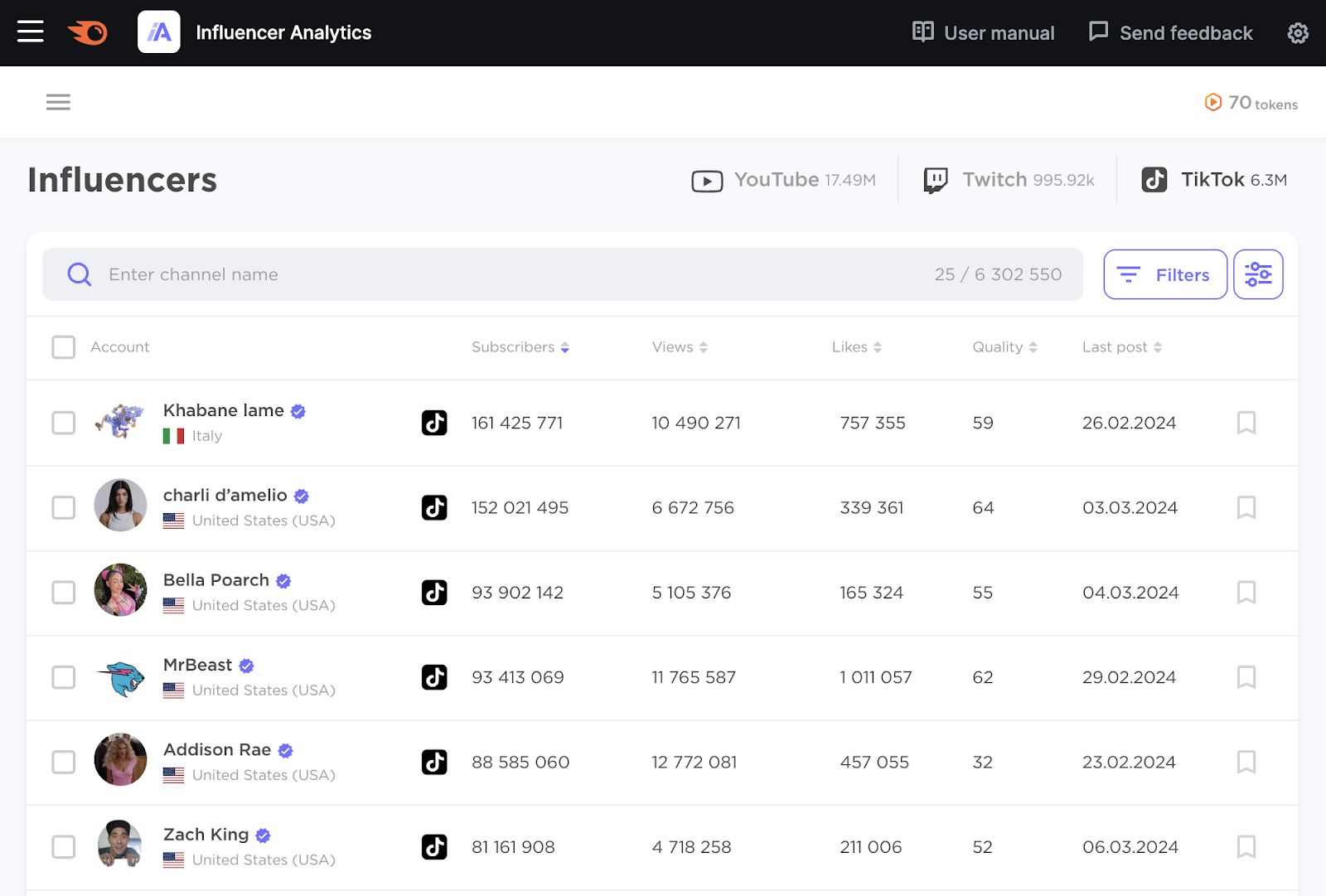
Third, provide your influencers with the necessary tools and support.
For example, what can you give them to promote your products or services effectively? Such as banners, links, landing pages, coupons, or product samples.
And how can you guide, motivate, and reward them for their efforts?
Finally, you should track and measure your influencer marketing campaign performance.
How well is your influencer marketing campaign achieving your goals and delivering ROI? And how can you use data and insights to improve your influencer marketing campaign?
Influencer Analytics can also help you plan, manage, and start campaigns. Since it gives you a single dashboard to monitor your influencers. And track and evaluate results in real time.

Further reading: Influencer Marketing: What Is It and How to Build a Solid Strategy
Choosing the Right Digital Marketing Channels for Your Business
You don’t need to use all the available online marketing channels. In fact, that’s a recipe for disaster.
Instead, focus on the channels that work best for your specific business, audience, and budget.
The key is to test and measure different channels. Find the ones that work best for you. Quality is more important than quantity.
Focus on channels that give value to your audience and your business.
Here are the three main factors to consider when choosing your digital marketing channels:
1. Business Type
Your business type is what you sell, how you sell it, and why people buy it. Different types of businesses need different channels.
For example, physical stores could use local SEO—which includes creating a Google Business Profile and listings in online directories.
Ecommerce stores, on the other hand, could benefit more from social media ads, email marketing, and influencer marketing.
2. Target Audience
Your target audience is who you want to reach, attract, and convert. You need to know them well.
Different target audiences have different preferences, behaviors, and needs.
For example, young and tech-savvy folks may prefer Instagram, TikTok and Snapchat.
While professionals and older people might like LinkedIn, newsletters, and podcasts more.
3. Budget
Your budget is how much money you can spend on your digital marketing campaigns.
Different digital marketing channels have different costs, benefits, and ROI.
For example, some channels are pricey but fast and easy to measure—like PPC, social media ads, and video ads.
Other channels are more affordable but slow and harder to track. Like organic SEO, content marketing, and email marketing.
Diversify Your Digital Presence & Reach Your Target Audience
You just learned about 10 awesome digital marketing channels. And how to use them to grow your business.
Pick the ones that fit your goals, audience, and budget. And test them out.
Then, double down on what works. And ditch what doesn’t.
That way, you can diversify your digital presence. And reach your target audience where they are.
That’s how you build trust, loyalty, and long-term relationships with your customers. And that’s the ultimate goal of digital marketing.
